Lotus
Alexdrina Chong
Rebecca Haque
Tan Puay Tee
Mastura Abdul Rahman
Wong Chee Meng
Cheong Kiet Cheng
Mohammad Ferdous Khan Shawon

Chang Fee Ming
issue

The Blue
no. 59 Autumn 2023
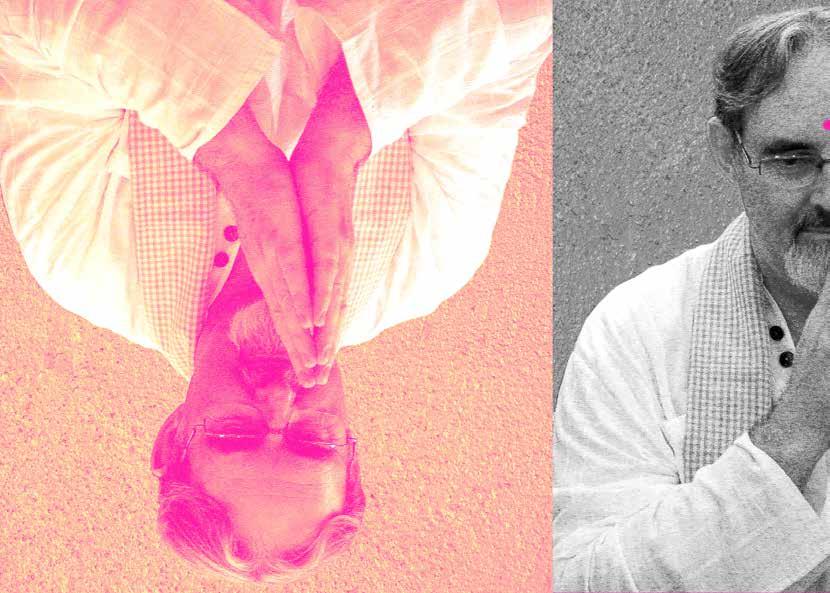
2
The Blue
Lotus
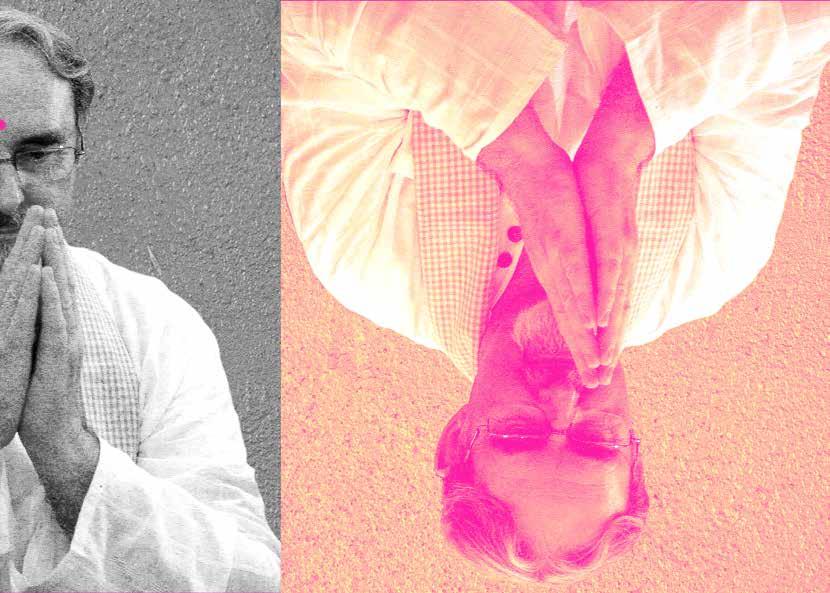
3
Image © by Martin Bradley
contents
A quick word Editor’s comments.
Christian Develter


Home visit, Siem Reap, Cambodia
Alexdrina Chong
100 Pages of Solitude bk1, Malaysia
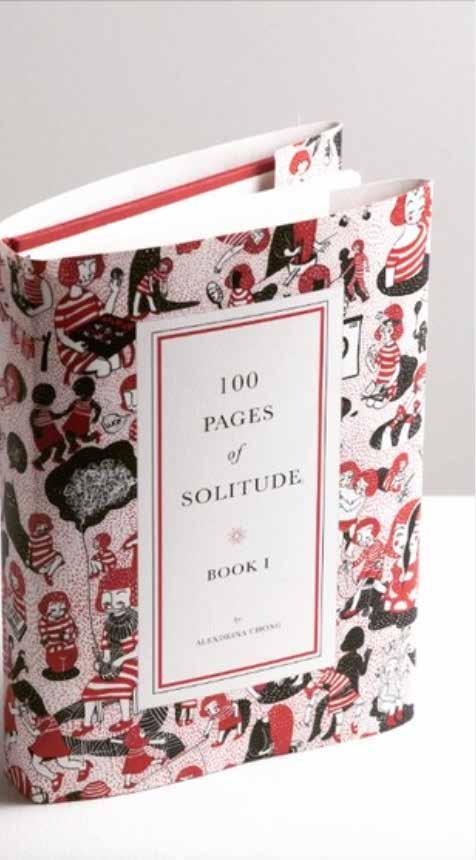
p36
Rebecca Haque
Ode to Remembrance, Bangaldesh
p38
Tan Puay Tee
Fresh Works, Muar, Malaysia
Mastura Abdul Rahman
p54

Pesan Ibu, Malaysia
p66
Wong Chee Meng

Rasa Sayang, Malaysia
p78
Malaysian Art Round-up 2023


A review, Malaysia
p90
Orientalist Paintings
Mirror or Mirage review, Malaysia

p104
Cheong Kiet Cheng
The Last Star before Dawn, Malaysia
Mohammad Ferdous Khan Shawon
p118
Bangladesh
p128
Malaysia’s National Art Gallery

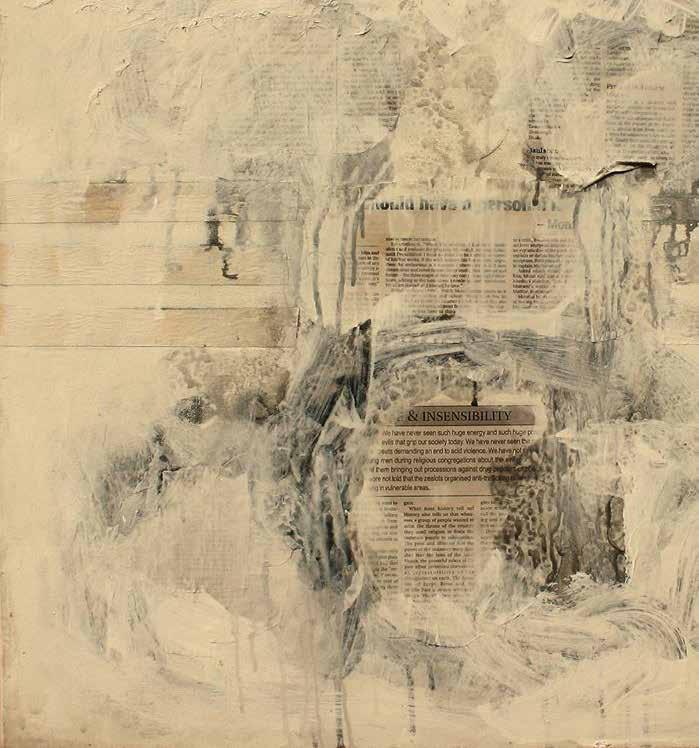
Retrospective, Malaysia
Sacha Inchi

p142
Omega 3, Malaysia
p146
Sarang Art Hub
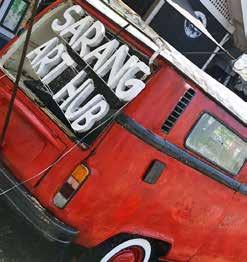
Mamat Khalid at Tanjung Malim, Malaysia
p156
Chang Fee Ming
Painting regional cuisine, Malaysia

p172
IMC Training
Cooked to Perfection Raaginee Shalesh, Malaysia
5 ISSN 2754-9151 • NO. 59 • AUTUMN ISSUE • 2023 • THE BLUE LOTUS Published quarterly by The Blue Lotus Publishing (M.A.Bradley), Colchester, Essex, England, UK. © 2023 M.A.Bradley. All rights reserved. FIND MORE ONLINE: …… facebook.com/bluelotusartsmagazine
A quick word Autumn
As I seem to have become somewhat of a ‘Digital Nomad’, this issue comes from Malaysia. Hence the Malaysian theme.
I have tried to give a flavour of the creativity and ‘art’ currently emerging from this melting pot of Asian races. Enjoy.
Thank you, as always, for being here and reading this magazine. Do come back to future issues or take a look at past ones on ISSUU.
Submissions are encouraged to be sent to martinabradley@gmail.com for consideration
Take care and stay safe for Covid 19 and its variants are, sadly, still with us. Martin
(Martin A Bradley, Founding Editor)

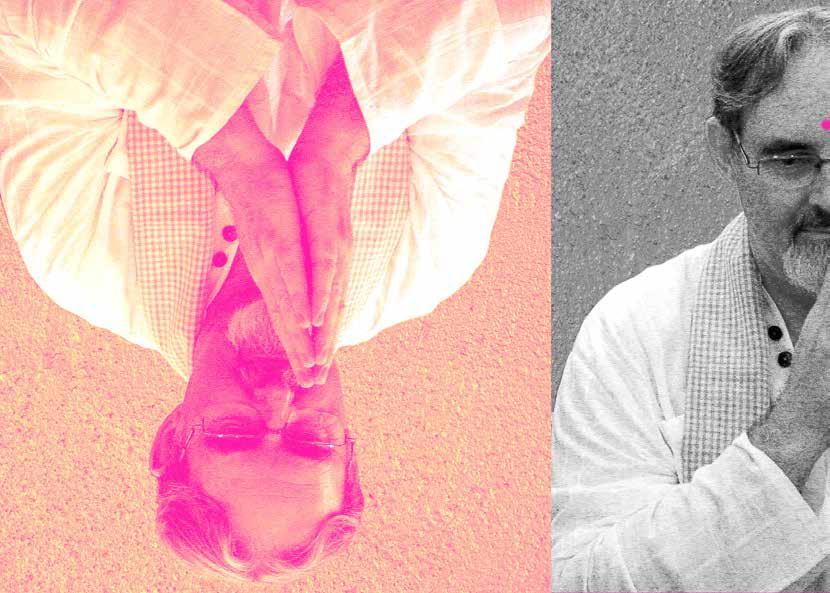
6 Lotus The Blue

7
christian develter

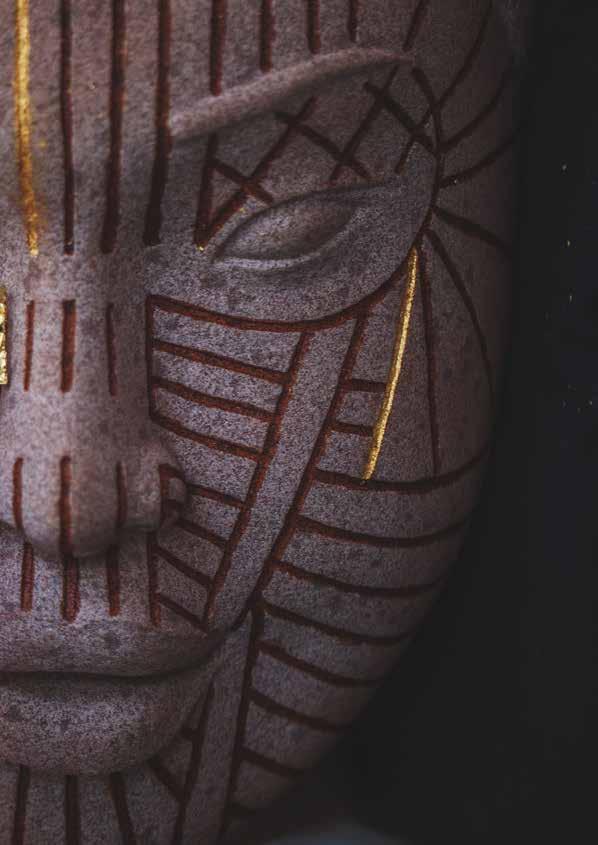 Māra Chin, Christian Develter
Māra Chin, Christian Develter
Māra meeting
Recently, I was in Cambodia. Siem Reap to be precise. Incidentally, the name Siem Reap literally means 'Siam defeated’. A reminder of an ages-old conflict between the Siamese (Thai) and the Khmer (Cambodians). In Siam (Thailand), that Khmer province and its capital were called Siemmarat, literally meaning 'Siam's territory’. To the Khmer it became known as Siem Reap, after the final showdown.
On my walkabout by the Siem Reap River, I had chanced upon the Develter Gallery. It’s conveniently adjacent to the Royal Residence (the official royal residence for King Sihamoni and family when they travel to Siem Reap) and the FCC (Foreign Correspondents Club, built in 1917 as the French Governor's residence), on Pokambor Ave, Krong, Siem Reap. It was there that I first met the Mara Chin, or at least their images.
It was a characteristically hot, bright, Khmer day. The Siem Reap River which, incidentally, is part of South East Asia’s Mekong River, took me through Siem Reap City on a conveniently shaded path, leading me surreptitiously to Christian Develter’s gallery and exhibition. The meeting was, seemingly, fated. A co-joining of Khmer mystic and cosmic forces, perhaps.
Within that cool and brightly lit gallery, Develter’s stylised portraits of Asians struck me. I became attracted to the Fauvist colour
approach, and with what might be misconceived as Warhol/Pop Art inspired flatness. Within that gallery Develter’s chic, and frequently blue-skinned, Asian portraits, encouraged recollections Myanmar’s past, it’s symbolism of blue as peacefulness and steadiness. I had idly wondered if the artist was encouraging a relooking at the Asian other through his somewhat graphically commercial imagery of the Myanmar Mara, Mara Chin
and whether this had arisen from Develter’s early studies in art at Ghent Art School, his subsequent training at the Antwerp Fashion Academy and his ever increasing fine art predilections. However, Anias Nin reminds us that…
“We do not grow absolutely, chronologically. We grow sometimes in one dimension, and not in another; unevenly. We grow partially. We are relative. We are mature in one realm, childish in another. The past, present, and future mingle and pull us backward, forward, or fix us in the present. We are made up of layers, cells, constellations.”
In that Siem Reap Develter Gallery, modern, risqué, stylised and stylish women pouted. The images presented young woman at home in their skins. Much like the real Chin women back in the hills of Myanmar. Those pictures were evocative and strong in an imagery which recalled not just Western artistic trends but the ‘modern’ women depicted in Shanghai (China)1930s posters,
10
(မရာလူမျိုး)
too. There were visual art-historical linkages between a world-travelling Belgian artist and the place(s) he has made his home in Asia - Bangkok and Siem Reap, with interests in China and the various Chin peoples of Myanmar (Burma) too.
I was invited (by email) to visit the artist’s domain.

I had travelled the scenic route out of Siem Reap city, bypassing 11th century and 12th century Wats (temples) where huge stones told of ages and stories past. The ‘remork’ (tuk tuk) driver and I travelled deep in rural area, bypassing
nascent rice paddy fields, all watery green with dogs chasing each other in the cooling damp, throwing up water as they ran.
Eventually, the gates to the artist’s rural realm had opened. They led me into a manicured jungle, part gardens, part sculpture park, part architectural haven. The hosts and I walked into the evening accompanied by birdsong. Before long we encountered Develter’s exquisite two meter high bust (statue). It was ‘Mara Chin’ (or ‘māra’ servant of the gods of love) again. This lady’s head was constructed of local Anchorian grey/blue sandstone, and greeted us with a
11
Māra Chin, Christian Develter

12
Entering another world
friendly, but enigmatic, smile. That beauteous face, lined with Chin ‘tattoo’ marks, had been up-lit. I saw the light illuminate her form from below, just as the sky behind it began to lose its colour. Between earth and sky, she sat. Asia embodied.
In the artist’s blurb it is mentioned that..
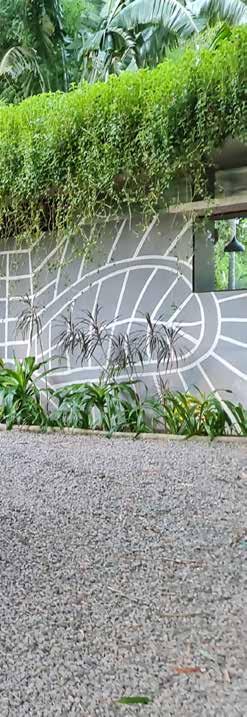
“Christian’s 'Chin Series' is inspired by the beautiful iconic Asian tribal women of the South East Asian Sino Tibetan ethnic group found in the remote Chin State of Myanmar.
Their facial tattoos being a signature to their tribal identity and regional location. This work of art by Christian is a homage to Siem Reap, it's cultural heritage and the local craftsmen where he fondly calls home.”
According to BBC Travel; “Chin legend has it that when a Burmese king travelled to the region, he was so impressed by the women’s beauty that he kidnapped one to take as a bride. Because of this, Chin families began to tattoo their daughters to ensure they would not be taken away.
Other Chin tales say that the tattooing was done for beauty, and perhaps more plausibly, to differentiate the different tribes in case one was kidnapped by another.
Another explanation may have to do with religion. Since the time of British colonisation, many Chin minorities have converted to Christianity or else accepted it alongside the animist beliefs. Some Chin remember being taught by their local pastors that only those who had tattoos would be deemed fit to go to heaven……The tattoos are made using leaves, grass shoots and soot. The leaves
13

14

15
Māra
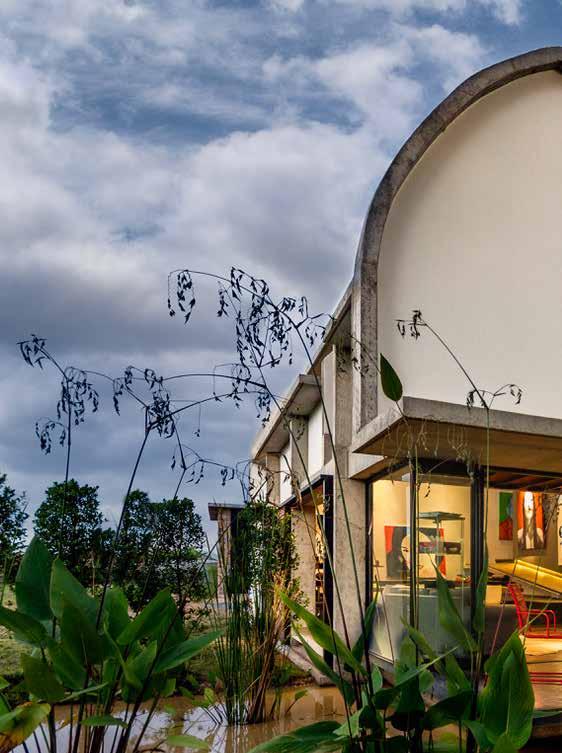
16
Christian Develter’s studio

17
give colour, the soot acts as a disinfectant and the grass shoots are added at the end, acting as a bandage and natural healing cover. The concoction is applied to the face using sharp cane thorns, which prick the skin to create the pattern ”.
I met the Mara again, in Develter’s purposebuilt studio. That studio was a revelation. An architectural delight. A clean-lined, expansive space which had been built with inspiration from Phnom Pen’s Art Deco Central Market (designed in 1936 by Jean Desbois), and the (German) Bauhaus inspired District 798, in Beijing, China. Inside that studio the functionality of concrete insisted that paintings and sculpture remained foremost in the artist’s mind (as well as the gaping visitors’ minds). Many commissioned works were in process. It was an exciting revelation to learn how each large piece would develop before encountering the commissioner’s adoring eyes.
The studio was but one of my surprises. In those equatorial grounds, Develter had recreated, and reconstructed, a rural, wooden house comprising of two former houses. The new abode heavily suggested the opening up of fresh vistas, thoughts and ideas into the minds and lives of its inhabitants.
Venturing into that copious house, with its romantically open lily pond vista and subtly moored, slim, blue boat, was as if entering an altogether different world of memories, signs, and symbols gleaned and gathered during nomadic travels. In wooden bookcases were books as diverse as Gregory David Roberts’ ‘Shantaram’ and Oscar Wilde’s ‘Plays, Prose Writings and Poems’. On the walls antique scrolls rubbed metaphorical shoulders with Asian statuettes, and a Tibetan ‘vajra’ (a legendary and ritualistic weapon, symbolising the properties of a diamond [indestructibility] and a thunderbolt [irresistible force] or so Wikipedia describes such an item). The whole, to me, presented two gentlemen of culture, education, and a sophistication tempered by a love of Asia, comfort, grace and relaxation.
Conscious of Phineas T. Barnum’s dictum of “Always leave them wanting more” I left. The remork ride back into Siem Reap City had me reflective, thoughtful and grateful.
That was a studio visit I shall never forget.
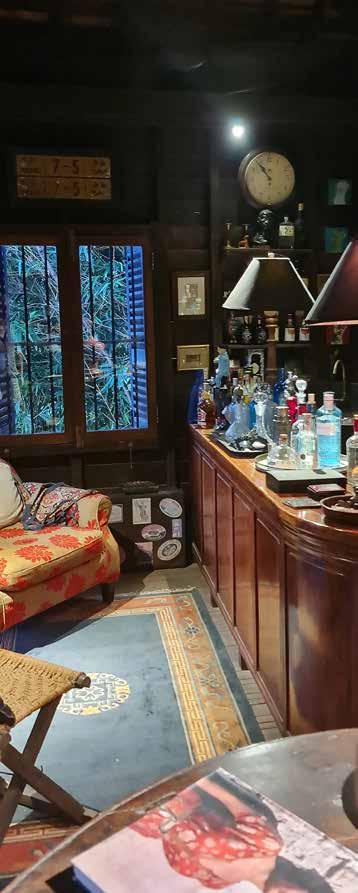 Ed.
Ed.
18
A place for spirits to reside

19
House interior
Opening up of fresh vistas, thoughts and ideas



ALEXDRINA CHONG
Alexdrina Chong is a creative director, designer, illustrator, educator and artist. She produces art under the name Alexoid Luce, and has been open about her mental health challenges, having been diagnosed with bipolar disorder in her mid-20s. When the pandemic hit, she had to spend a lot of the lock-down period alone, and in 2021, she cranked open an empty journal, and started to draw. In Alexdrina's own words, what started off as casual visual journaling swiftly took the form of a dark and satirical characterisation of her experience as an Asian woman, with a fragile and defensive inner child lurking within. One Hundred Pages of Solitude: Book 1 is a book about love, and is a compilation of 100 images from all three journals dated between May 2021 to April 2022. A pre-order campaign was launched on the 13th February, in conjunction with Self-Love Day. Alexdrina joins us to share more about her work, and the catharsis her art provided her, to cope with difficult times.
23
My earliest memory of creating art is with my mother. When I was a kid, mum would draw outlines of stuff to let me colour. So my earliest memory of wanting to create my art is rejecting mum’s drawings, so I can have something of my own.

I was trained in graphic design and media studies. In the 90s, that’s the most practical application for my interest in art, an interest otherwise considered as an “uh-oh”. Without classical training as a painter, or a ceramist, art remained a hobby throughout my adult life rather than a pursuit in life until the pandemic in 2020.
The pandemic has granted me a non-reactive space to create and reflect. I started a visual journal portraying the constant unease I experienced while isolated at home alone. Yoshitomo Nara, a Japanese contemporary artist has an apparent influence on my characters. Nara is known for his signature sad and malevolent characters expressing a range of emotional complexities in human anxiety. Similar to Nara’s, my illustrative style in this journal portrays the pervasive unease I felt growing up in an Asian upbringing of disciplined scrupulosity.
The entire series is a confessional piece describing my personal journey with Bipolar
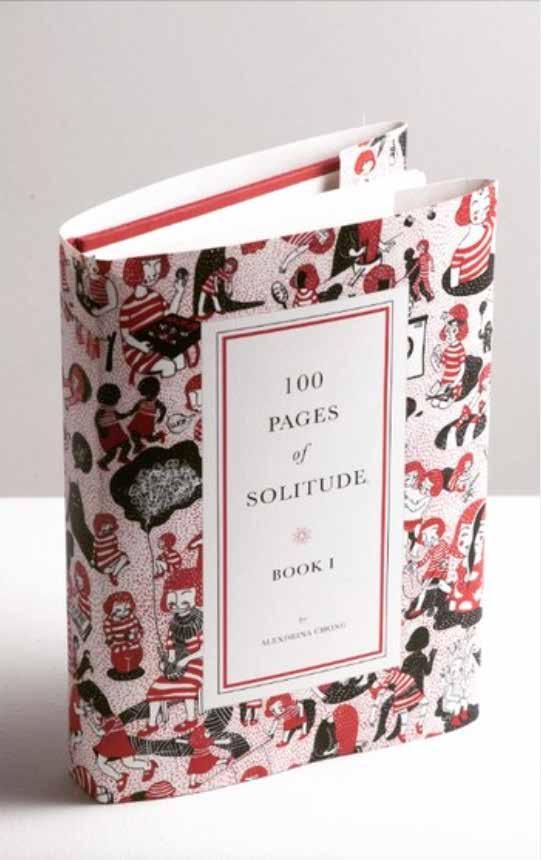
24
Disorder, a fragmented self constantly seeking a dignified moment of clarity and harmony. This work started off as casual visual journalling but it swiftly takes the form of a dark and satirical characterization of my experience as an Asian woman with a fragile and defensive inner child lurking within. This work has now evolved into the fourth journal with two key recognizable characterizations, a chaotic little girl and a twoheaded Chinese Lady.
This series has now evolved into the fourth journal and expanded into other mediums. The first medium I explored under Cendana Visual Production Grant was ceramic. The once single-

This is a collaboration with Zen Ceramic in Melaka, working closely with a young and enthusiastic ceramic artist based in Melaka, Khoo Pei Haow. Khoo is originally a graphic designer and animator but finds greater joy in crafting ideas with his hands.
I call this series, I am therefore I think, playing off Descartes’ ‘Cogito, ergo sum’. An invitation to space to reflect on the inherent frailties that make us human, and to ask ourselves, have we misunderstood frailties completely?
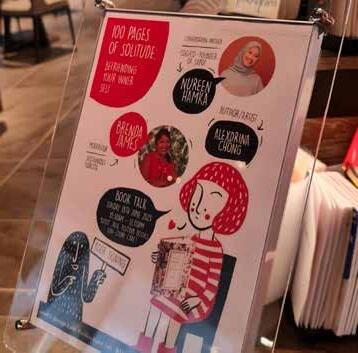
25
page
to think
narrative has been challenged
100 Pages of Solitude – Book 1
Alexdrina Chong 2022. Primaluce77
Softcover,21 cm x 15 cm
ISBN: 9786299818915


27
Gardening
Grim fingers


食自己 (Sek Ji Gei) Eat yourself
Raining thoughts


31
Bullet proof
I was once a tree

32

33
Reverse psychology

34
Unzipping
Fresh thoughts

35
Alexdrina Chong aka Alexoid Luce is a creative director, a designer, an illustrator, an educator and an artist based in Kuala Lumpur, Malaysia.
Ode on Remembrance
Elegiac Lines upon Parting
Rebecca Haque
Death has been on my plate these last few days. I am surfeit with it. I stare blankly at the flickering images on the screen. The wailing mother, the distraught wife, the forlorn son. My eyes burn, there are no tears. My heart bleeds. Teardrops will fall later, at odd, inexplicable moments. Even in sleep, one weeps.

I remember Bhashon from my first days as a student at the University of Dhaka. A friend pointed to him standing across from us on a parallel corridor at the farthest end of the English department, and she said in reverent tones," that's Munier Chowdury's son". I never knew him personally, never heard his voice, but I can recall his languid walk and his wavy long dark mane. For me, he was enshrined in the halo of his martyred father, and in my mind I found the poetic English equivalent word for his name: eloquence. Today, after nearly four decades of separation, I see him again, hunched over his dear brother's battered body. I look away to mourn in silence.
I remember Munier Chowdhury. I remember how he propelled the Bangalee people towards progress and the dream of universal literacy with his brilliant invention: 'Munier Optima'. Mishuk Munier returned to take up the struggle. I remember Zahir Raihan too –whose flame was rekindled in this land by Tareque Masud. Tareque found his destiny and true vocation and a gifted soul-mate. Today, I salute Catherine Masud for her passion and dedication.
Zahir Raihan's face was etched in my memory as I wept and watched 'Stop Genocide' one particular night at a place one thousand miles away from my motherland. I remember the long months I spent trapped in the army camps at Bannu and Mandi Bahauddin; days and nights of wakefulness and alert immersion in every new development in the nascent democratic nation to which I yearned to return. I prepared myself to meet my own destiny; in that barbed enclosure I quietly made myself ready for my chosen vocation. As chance would have it, I entered the class of First Year (Honours) batch in the Department of English on December 6, my birthday, in the year 1973, five months after classes had begun, after repatriation via Lahore on a chartered Interflug flight on December 3, 1973.
I remember that we all– class-mates and batchmates in other departments—lived at a time of such buoyant optimism and vibrancy that joy was visible in our jaunty footsteps on the thoroughfares and avenues of Dhaka. Eyes luminous with the quest for knowledge, we were a loud, merry band traversing the open grounds of the beautiful Campus. The hundred flowering trees rejuvenated us every Phalgun with a riot of glorious magenta, yellow, white, and purple, interspersed with a profusion of the majestic scarlet of the Krishnachura. Future economists, historians, sociologists, lawyers, administrators, entrepreneurs, and litterateurs, we would parade in groups up and down Fuller
36
Road up to BUET, or down from TSC to the Fine Arts Institute for the sensual, visual experience of the latest exhibitions and mounted displays, and oftentimes we would sit awhile gazing at the artist breathing life into clay or canvas.
Oh, what thrill it was to be alive in that dawn of our time! Creation was alive and we echoed its creativity. But today, it seems the cosmic Joker has our land in the cold claws of calamity. Such great and needless devastation, such irreparable loss, such sharp inconsolable pain. A foul odour reeks in the city. The clouds weep acid rain.
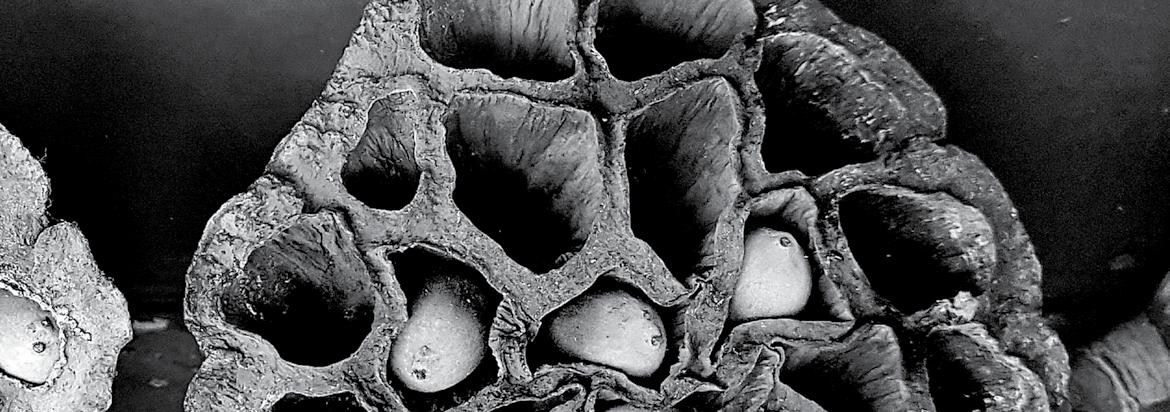
Yet, softly, I sing to you, my brothers and sisters, do not despair. The future is ours to save for our progeny. I remember my own dark abyss of despair in my personal odyssey of grief. I remember I looked up at the silver moon and the twinkling stars to steer my spirit. Hemanto and Barsha and kalbaishaki fanned the dying embers slowly into a flaming will to power and life again. I say to you, we have the strength, we have the power. Why should we blindly grope in darkness when the light is within each of us? Therefore, rise up, my fond friends, and before the final parting, raise arms against apathy and moral degradation and dumb anarchy. Let today's tears become a catalyst for an anthem of regeneration and purification.
Steel yourselves for the struggle, and ask, shall true-blood sons die in vain? Shall the dream of Sonar Bangla fade away with the flight of the
Copyright (R) thedailystar.net 2011

37
dusky Doel?
Rebecca Haque is Professor and Chairperson, Department of English, University of Dhaka.
TAN PUAY TEE
fresh works
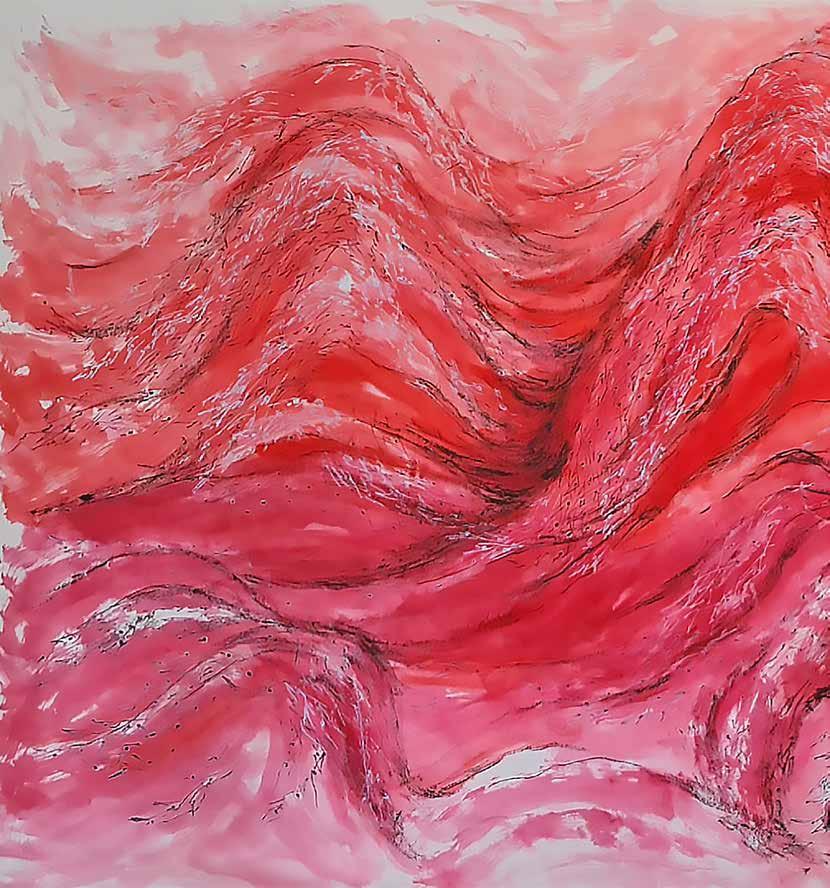
38

39
TAN PUAY TEE
Recently I had the great fortune to re-visit the heritage town of Muar, in Malaysia’s State of Johor. My Chinese Malaysian artist friends, the husband and wife duo Yeoh Eng Hin and Chay Hwa Chua, had been very kind to transport me the 183.4 kilometres (or three hours) from Puchong, Selangor, to see the self-taught artist, my friend the Chinese Malaysian artist Tan Puay Tee.
We met with him at his home, just on the outskirts of Muar. We stopped, en route, to grab breakfast at a Relax (R&R) area along the North-South (PLUS) Highway. I’d had a typical Malaysian breakfast of roti bakar (toast with coconut jam - kaya, and butter) a half-boiled egg as well as kopi susu (local thick Robusta coffee with condensed milk). It was if I had never been away, but the reality had been that I was absent from Malaysia for three years. I was glad to be back.
Tan was amidst moving house to Kuala Lumpur. His long standing wife had recently, sadly, died and, as Tan is no longer
40

41



44
young, his son had suggested that he move in with his son’s family. I was there to pay my respects, and to see some of Tan’s artworks before the move.

The royal town of Muar never disappoints, nor does Tan. For some years I had been involved with writing for Tan and talking at many of his art displays, ever since an initial meeting in Malacca. I have been continually amazed at Tan’s works, be they oils, acrylics, print or watercolour/xuen paper Chinese Ink Brush imagery.
On this particular occasion, Tan was also being interviewed by a gaggle of photographers pushing their long lens in his face, rearranging his furniture and generally behaving as paparazzi anywhere. The trio of us from the Kuala Lumpur environs revisited late that evening, just as the Muar sun was setting and the mosquitoes intent on kissing, for a more intimate get together.
On that occasion Tan talked us through some of his watercolour/xuen paper Chinese Ink Brush imagery, which he had sequestered in a box room. Those works were more subtle in colour than his oil or acrylic paintings, for those paper images had a uniqueness and depth of symbolism all of their own, developed over Tan’s lifetime of producing art.
While I would prefer not to label Tan’s uniqueness, some of his image making could quite easily have fallen under the umbrella of Nanyang art (that Malaysian/Singaporean blending of art incorporating aspects of visual art from China and School of Paris as well as reflecting the life of South East Asia). Others were different from others I had seen. Unlike my travelling companions, Yeoh Eng Hin and Chay
Hwa Chua, who had both studied in Singapore and Paris, Tan had received no formal art training at the Singaporean Nanyang Academy of Art, nor the Ecole nationale supérieure des Beaux-Arts but, instead, had studied his art independently, while spending a working career teaching at prestigious Chinese schools in Muar.
Tan’s artistic production has therefore grown unhindered by narrow definitions, and is enriched by his own imagination, observation and symbolism, like Henri Rousseau and Paul Gauguin before him. Unlike Rousseau, Tan has not walked the ‘Primitive’ (Naïf) path but, similar to Gauguin (who incidentally was a role model for some Bali Nanyang painting) Tan has developed to be free thinking, and has responded to his environment, culture and his own natural creative symbolism, very much in his own unique way.
45
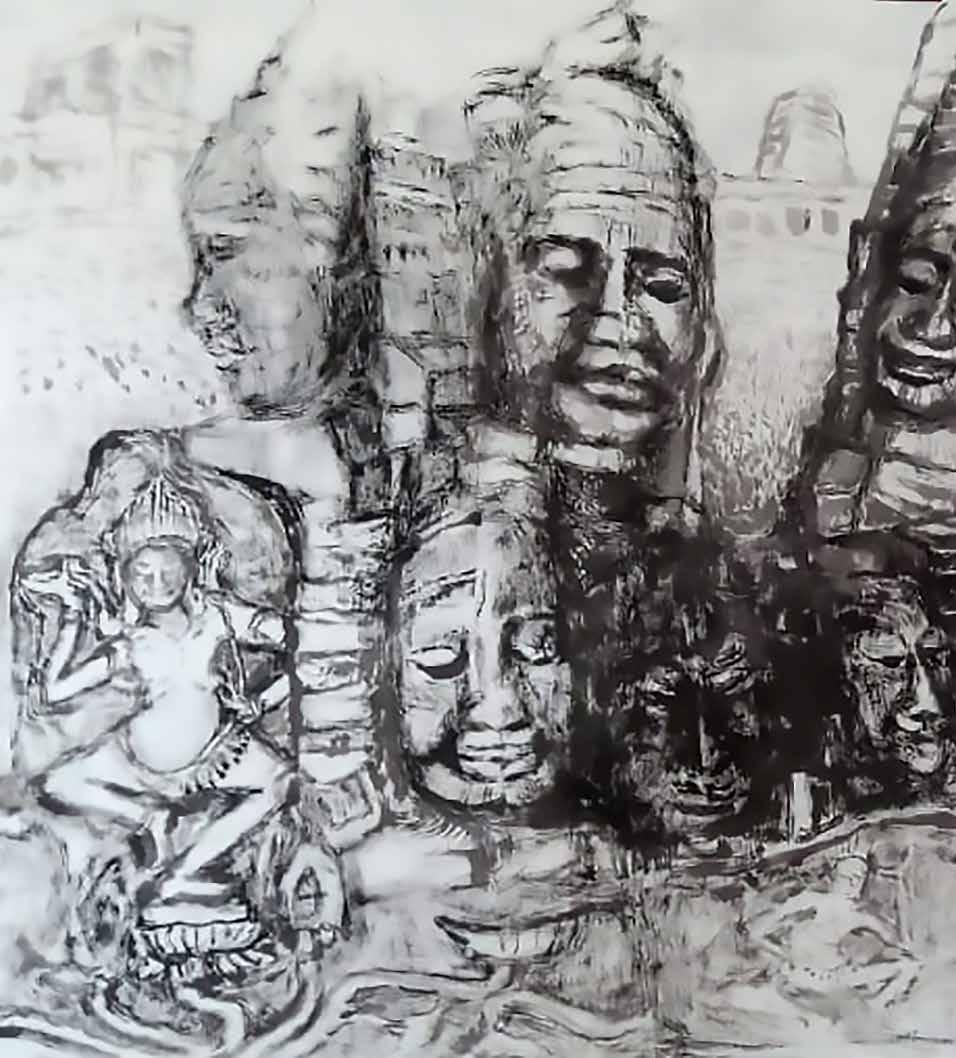
46

47

48
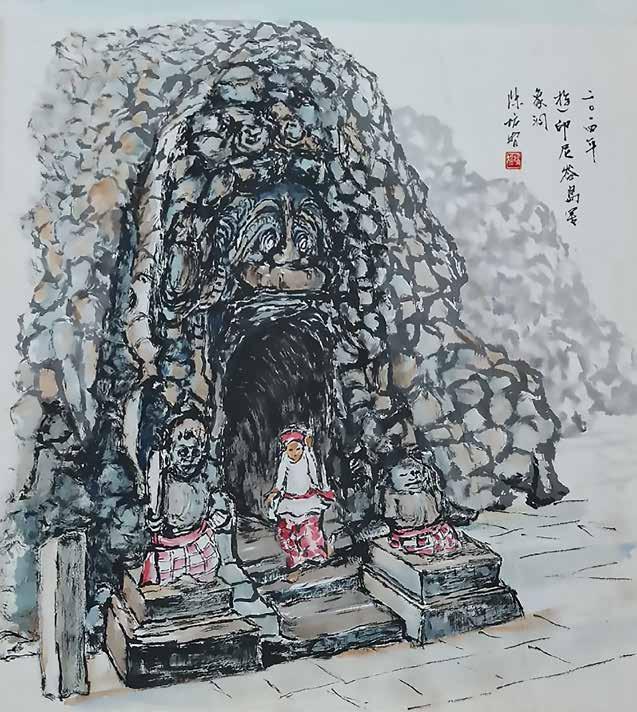
49

50

51
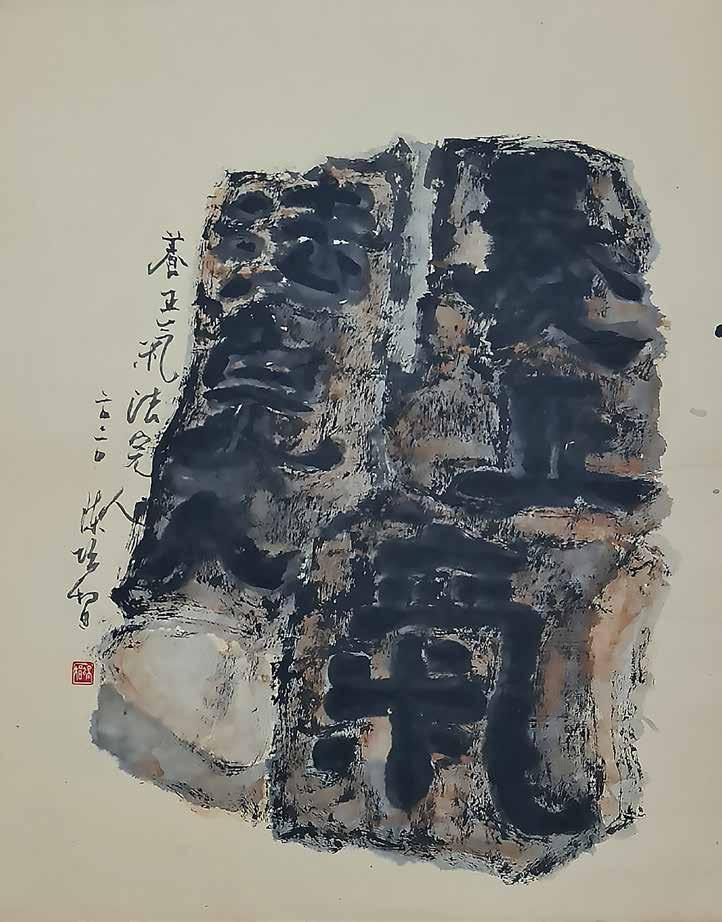
52
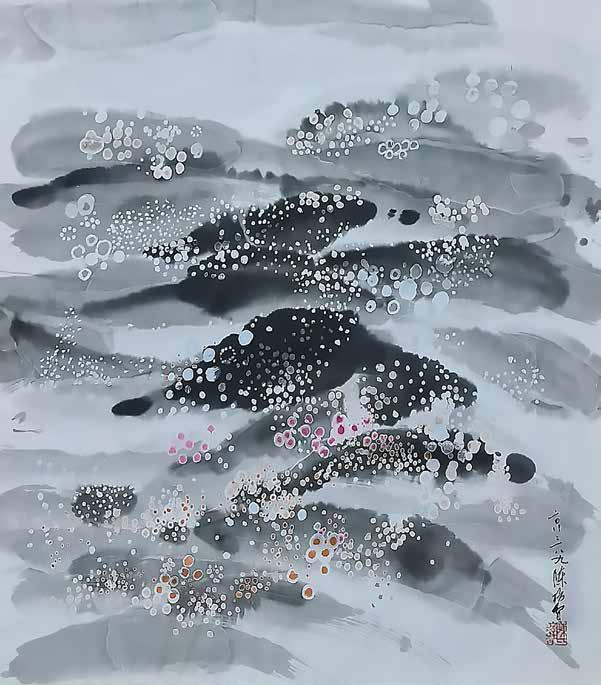
53
Pesan


Mastura Abdul Rahman
FERGANA ART SDN BHD Lot 20, Level G4, Block C5, PUBLIKA Solaris Dutamas, No.1 Jalan Dutamas 1, 50480 Kuala Lumpur MALAYSIA.
E exhibitions@fergana-art.com
FB www.facebook.com/fergana.art, IG fergana.art
54
Ibu Alam Dijaga Petua Diingat

55
A Mother’s Perspective
Malaysia’s Publika Solaris Dutamas (Publika mall if you prefer) is not hard to find. Discovering Fergana Gallery within that mall is an entirely different matter. That is, unless you have a member of the female sex by your side. Men will inevitably trudge on, looking at digital maps this way and that and getting nowhere fast. Women will simply ask for directions from any capable looking person, and head straight away for their destination. Obviously I kow-towed to the superior specie.
‘Pesan Ibu; Alam Dijaga Petua Diingat’ (in reminiscence of a nurturing mother, or a mother’s reminder) was the title of Malaysian artist Mastura Abdul Rahman’s latest exhibition at the Fergana Gallery. It was within that Publika mall.

Pop Art, which the art auction house Sotherby’s calls an “…appropriation of imagery and techniques from popular and commercial culture”, became an international art ‘style’. Not least in Malaysia.
Along with Malaysia’s (now departed) artist Redza Piyadasa (1939-2007) with his Warhol inspired ‘Malaysian Series’ (1980 - 2005), Zulkifli Yusoff’s ‘Harimau Malaya I’, and ‘Merdeka 57’ (both 2009) and, to some extent, Joseph Tan’s iconic ‘Love me in my Batik (1968) painting, Mastura Abdul Rahman’s work has distinct echoes of a Pop Art which had brought art to the masses in the 1950s/60s, and vice versa.
In Mastura Abdul Rahman’s works, aside from her interests in Persian and Mughal miniature
56
paintings, Ukiyo-E prints, the Malay traditional architecture and decorative arts, you might just discern juxtapositions reminiscent of the art of the Pop-artist Richard Hamilton (1922–2011) and his work. More especially ‘Just what is it that makes today's homes so different, so appealing’ (1956) or, there again, you may witness the unusual Pop Art perspectives of Eduardo Paolozzi (1924–2005).
As with the aforementioned Piyadasa, Mastura Abdul Rahman uses elements of Pop Art to explore her cultural and personal history. Stemming from her birth as an ethnic Malay, into a multi-ethic, multi-cultural country where personal identity has been frequently tied into ethnicity, race and religion.
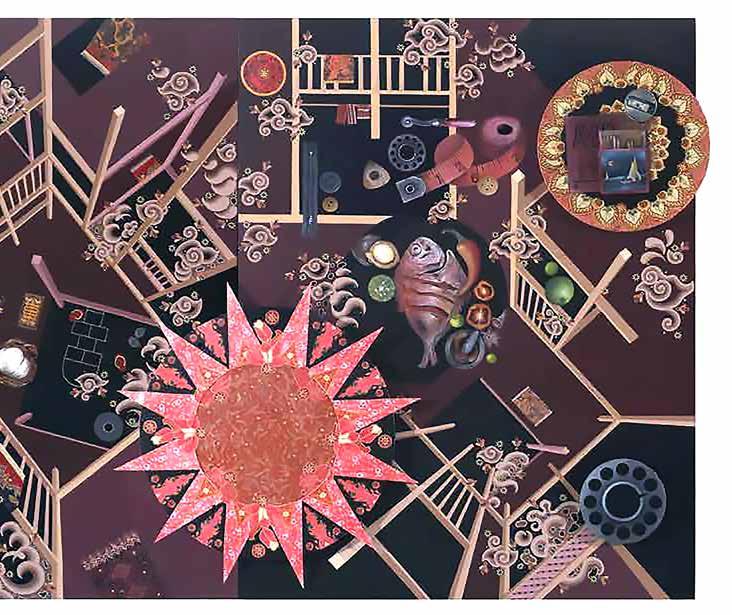
In carefully constructed perspectives, the viewer ‘falls’ into the artist’s work. It would seem that
Mastura Abdul Rahman purposely eschews the usual Western influenced geometrically/ architecturally based perspective (Italian Renaissance including 14th - 16th centuries, with the inclusion of linear perspective). Instead she creates perspectives in her works which appear to be more akin to those of Picasso and Braque’s ‘Cubism’; or Paul Klee’s experiments with works like ‘Transparent in perspective Grooved’ (1921) or, there again, the innovative Expressionist film-makers such as Robert Wiene (in ‘The Cabinet of Dr. Caligari’, 1920) or, later, Alfred Hitchcock (‘Vertigo’, 1958). Innovative perspective has, incidentally, also been featured by comic-book artists such as Will Eisner (see “Black Alley” [June 5, 1949], script by Jules Feiffer, art by Will Eisner).
Back in 2012 (in - ‘Imagining Identities: Narratives in Malaysian Volume 1’, published
57
‘Gubahan Selerak 7'
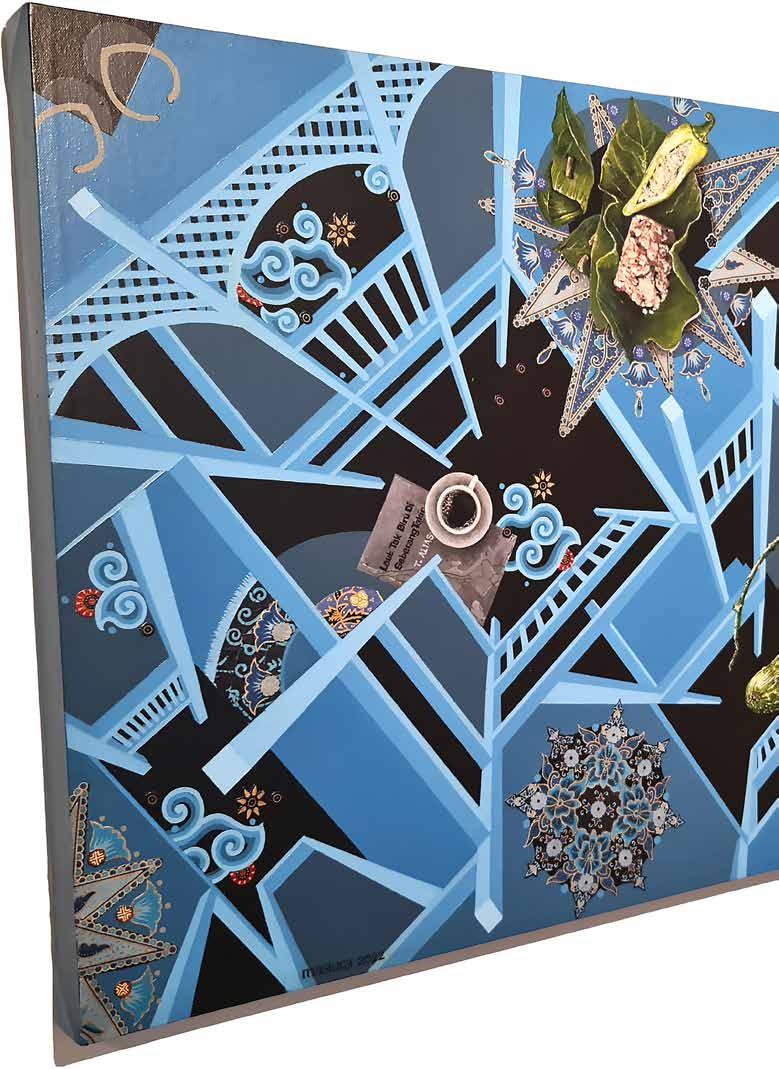
58

59
Gubahan Selerak 1
Redza Piyadasa, Dua Orang Wanita Melayu
by Rogue Art) Siti Zainon Ismail (Malaysian novelist, writer, poet, and academic) concluded her essay (‘Menulis dan Melukis: Writing and Drawing in Malay Traditional Art and Their impact in Modern and Contemporary Art - A Study of Cultural Values’) by saying that “Malaysian citizens should come together through a consciousness of their roots. Where we stand on earth is where we hold up the sky…” Consciousness of her roots is what Mastura Abdul Rahman’s works are all about, in an intended inclusive way.
There is no disguising that Mastura Abdul Rahman’s artworks are retrospective, and maybe a tad nostalgic too. In the preface (a note on the wall in fact) to the Fergana Gallery exhibition
the artist had mentioned…
"I like Nusantara forms such as Batik, Songket, Anyaman and others. Maybe because these forms can remind or connect short story me with the past…
My relationship with Tengku Sabri and Mad Anuar who actually practiced the production of modern/contemporary works through traditional disciplines further strengthened my belief and interest, to produce Malay-shaped works like what I am producing now.”
(For those unfamiliar with the name, Mad Anuar might be better known for his work ‘Storm Rider No.17’ (a homage to the sailor Azhar Manor and the ‘Sea People’ [Orang Laut] in general), and Tengku Sabri (Ibrahim) for his images such as ‘At the Beach’ [1991]).
Through Mastura Abdul Rahman’s visual vertiginous perspective, the viewer enters into both notions of her ‘kampong’ (rural) past, and into a ‘golden age’, or ’retrospective illusion’ where the past is Arcadian, the races and religions are united in kopitiams (local Chinese/Hailam inspired coffee houses) or (Tamil) Muslim ‘Mamak’ eateries, where they chit chat, equally mindful of each other’s beliefs and lifestyles.
The artist’s latest piece greets the visitor to the show ‘Pesan Ibu’, before they even enter into the gallery. The main door to Lot 20, Level G4, Block C5, Publika Solaris Dutamas is open. Directly in front of the visitor sits the triptych ‘Gubahan Selerak 7' (or ‘Scattered Composition 7’, 2023). Flippantly one might say that all ‘Malay’ life is there. It’s not of course, but you might be forgiven for thinking so as that large three panelled painting seems to cover a lot of social, and personal ground from scattered meals and utensils, to featured books. One book (‘Mat

60
Kilau’) references a local Malay hero, another (‘Tunjuk Ajar Melayu’) is a book of advice and counsel, etc while yet another (’Syair, Syair Melayu Riau’) concerns itself with historical interpretations of the Malay community. Atop of which sits a very symbolic bowl of dates (an intimation of the ‘fasting month’).
The viewer is drawn to glance into Mastura Abdul Rahman’s canvas triptych, welcomed by a palette of predominantly brown (coklat) and
black (hitam). To delay the viewer’s ‘fall’ into the canvas, the artist has placed circles of interest as well as decorative ‘stars’, which present designs familiar from Malay couture such as the ‘Baju Melayu, the ’Baju Kurung’ and the sarong (Malay traditional attire), as well as a section devoted to couture production.
The artist painstakingly presents ‘Trompe-l’œil’ Malay paraphernalia, ingredients and cuisine (including a pestle and mortar with ingredients

61
Zulkifli Yusoff, Harimau Malaya I
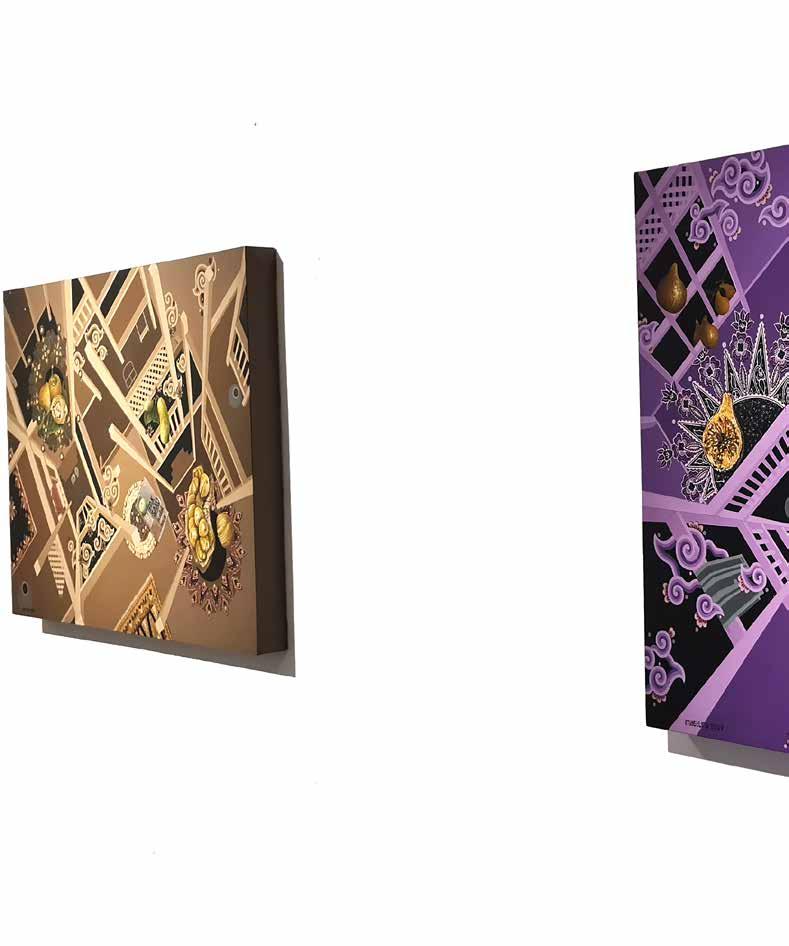
62
Gubahan Selerak 2
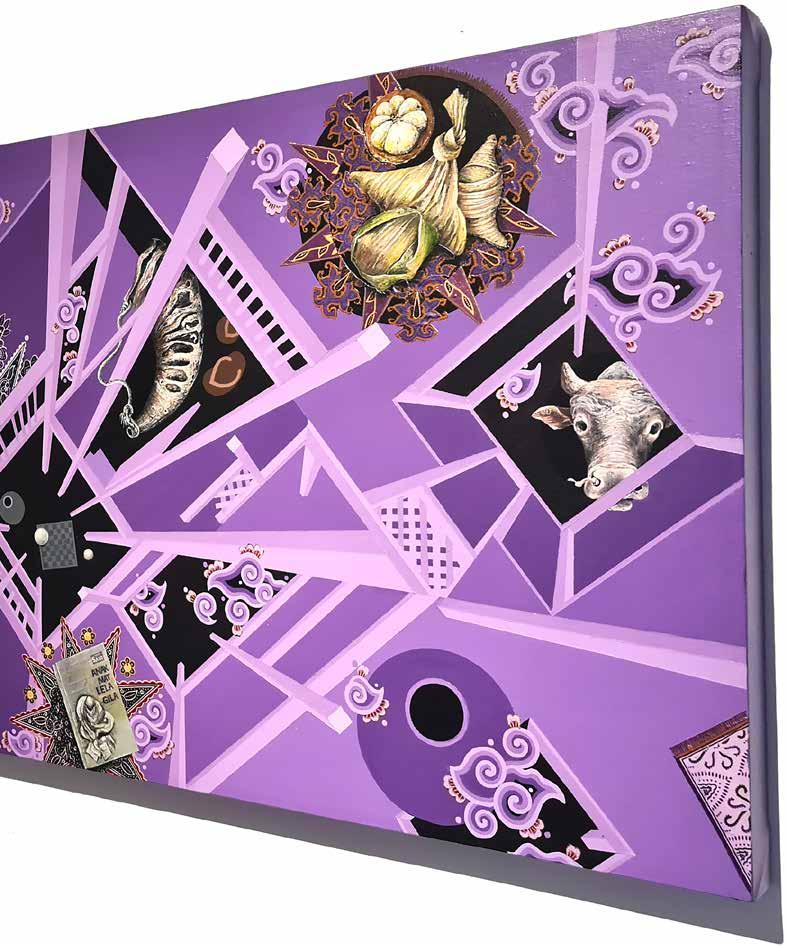
63
Gubahan Selerak 4
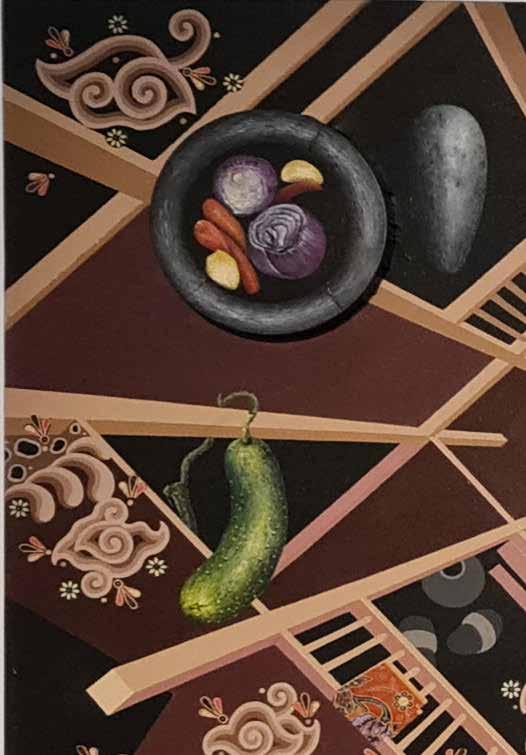
64
‘Gubahan Selerak 7' detail
ready to be pounded; banana, rambutans, mangosteen, Calamansi Lime, purple banana flower et al). The artist also proffers a traditional fried fish with its spices beautifully painted, while a nearby kaffir lime provokes the viewer’s attention.
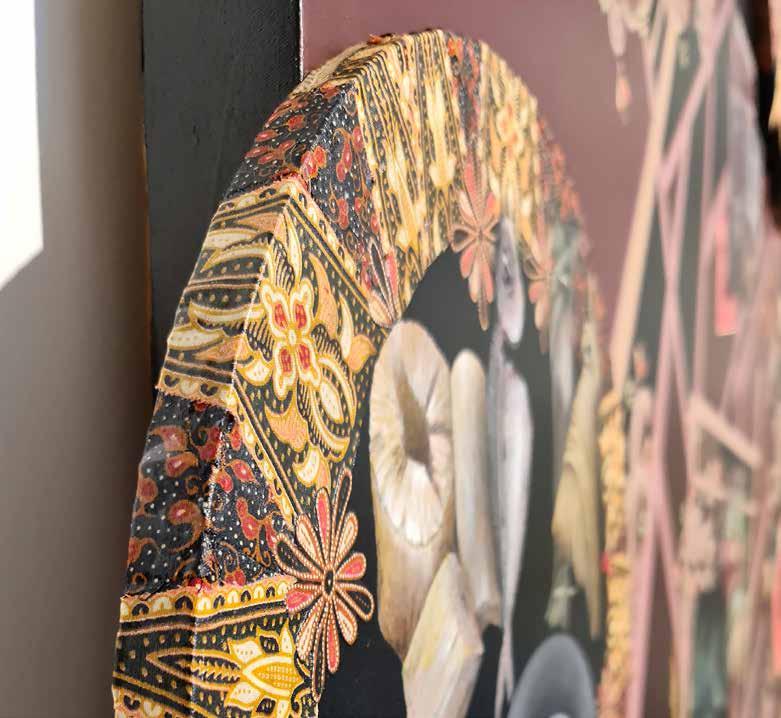
As if this is not enough prestidigitation, there is further illusion, over and above perspectival intrigue and the ‘Trompe-l’œil’, which presents three dimensional objects affixed to ‘Gubahan Selerak 7’. These objects include a disc mounted eleven-pointed star, replete with painted textile and floral designs, and is symbolic of the unity of the country’s (11) member states. The second object is a platter painted to resemble sarong textile, with a cup of ‘Kopi O’ (black, traditional, Malaysian coffee) on a saucer, accompanied by various foodstuffs. The ‘platter’ extends beyond the triptych’s frame, casting an additional shadow onto the gallery wall. The ‘Gubahan Selerak 7’ assemblage echoes another of the artist’s works from 1991 titled, appropriately, ‘Interior 1991’.
In the exhibition ‘Pesan Ibu’, there is a lot to unravel. I have only touched upon a faction of the wealth of information in Mastura Abdul Rahman’s works. Ideally, this exhibition should be on permanent display at the Kuala Lumpur International Airport, (KLIA) for foreign visitors to gain some insight into one of the country’s cultures, before entering the country.
Ed.
‘Gubahan Selerak 7'

66
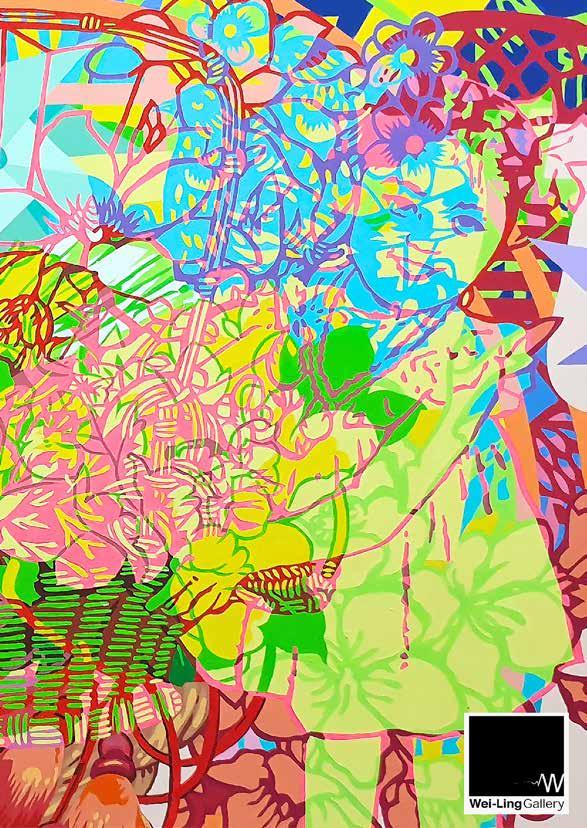
67
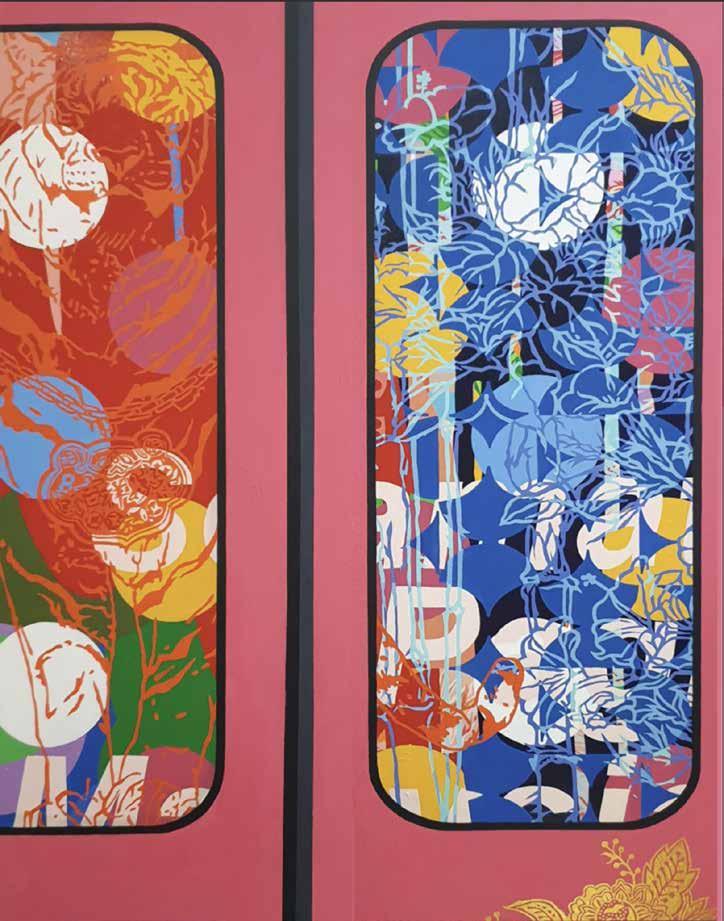
68 A New Day
Wei-Ling Gallery presents 'Rasa Sayang', marking the fifth solo exhibition by seasoned Malaysian contemporary artist, Wong Chee Meng. This innovative body of work explores the experiences of living in a multicultural environment and aims to restore love and positivity towards forging a “new” Malaysia, while showcasing Wong Chee Meng's unique exploration of cultural perception and artistic expression.
“With 'Rasa Sayang', Wong Chee Meng unravels the core essence of Malaysia's identity by drawing inspiration from the amalgamation of diverse cultures that have shaped the nation. Across his works, Chee Meng displays a myriad of richly coloured hues, which are an essence of the nation itself, through concepts and compositions, all while orienting towards acculturation. The artist deftly peels back the layers of influence that have shaped our perception and connection to Malaysian heritage.
The title of the exhibition, ‘Rasa Sayang’, takes its inspiration from a Malay folk song. This well-known melody, deeply ingrained in Malaysian culture, represents unity and love. Wong Chee Meng references the song to honour its influence in fostering a shared common ground and appreciation for cultural diversity.
"Finding common ground is perceived as an effort to converge the mental representation of shared knowledge, it enables us to create shared memories, allow us to activate, seek, and rapport building, as well as knowledge building that could be built in the communicative process," says Wong Chee Meng.
69
@weilinggallery
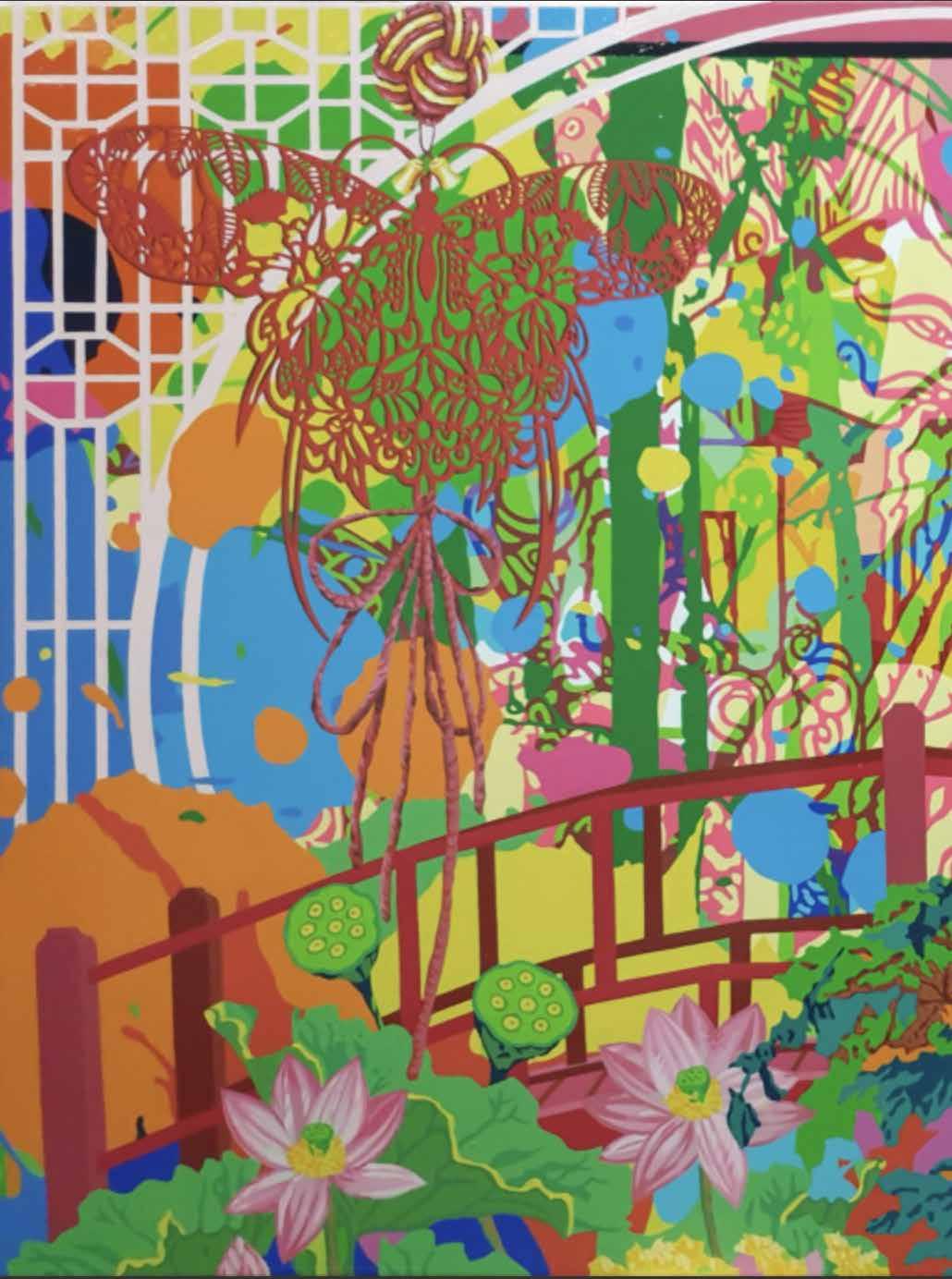
70

71
Love Song

72
Enchanted Garden

73
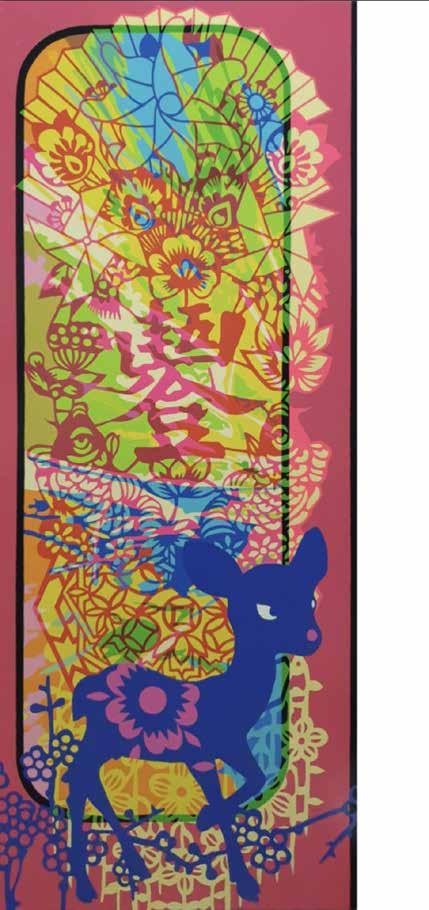
74

75
Golden Flower
Together Towards Growth

76

77
“
Malaysian Art Roundup2023
….the most current impulses towards conceptual tendencies, the reflection of Malay sensibilities, and art as a means for documenting social issues are varied attempts to resist the orthodoxy of mainstream international formalisms and styles, in favour of incorporating ideas and values supported by historical and cultural contexts.”
(Modern Artists of Malaysia, T.K.Sabapathy, Redza Piyadasa,1983.)
Forty years ago T.K. Sabapathy and Redza Piyadasa made a brave attempt at rounding up the then current trends for art in Malaysia. It was a time when Malaysian art was still emerging. A time when many artists had sought their art school training outside of Malaysia or, simply, went it alone and self-taught. Artists such as Chang Fee Ming and Ali Rahamad (who had been a member of the Anak Alam group and the Angkatan Pelukis Semenanjung [APS] which had been formed in the 1970s) had, bravely, developed their own styles and succeeded in surprising the art establishment of the time, and continue to work as senior artists.
Four decades on and Malaysian art has grown to be even more diverse, with fewer young artists seeking places at external art schools, and taking advantage of the growth of schools of art in Malaysia. They do not, however, entirely shun styles of art and influences from outside of the country, but draw from them in their own innovative ways.
What is presented here is but a soupçon, a small taste of the vibrant visual art now to be found in Malaysia during 2023. Many of the younger artists have returned to more figurative forms of visual art, some have not and forged ahead in fresh ways. In many respects the old ‘Modernist’ styles like Surrealism, Expressionism, Pop Art and Abstract Expressionism (and their bounding boxes) are gradually becoming meaningless, irrelevant, as younger artists continue to experiment.
Ed.
78
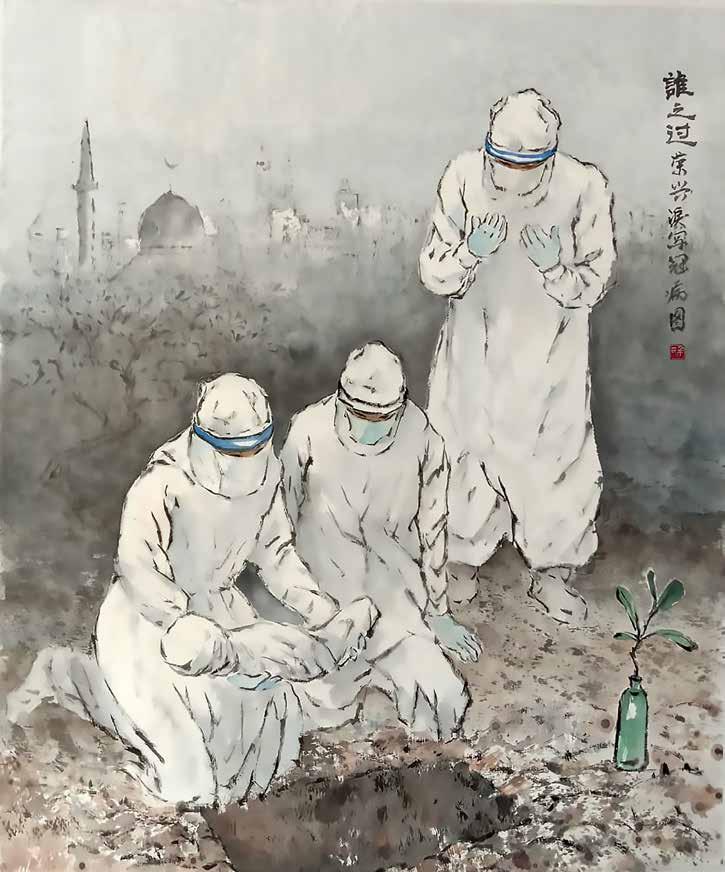
79
The Tragedy of Covid 19, Yeo Eng Hin

80
Kopitiam, Chay Hwa Chua

81

82

83
The Malaysian art gallery G13, thirteen years on

84
Embryonic iv, James Seet

85
Bird cage ii, James Seet
A continued pattern, Caryn Koh

86

87

88
Daisy-Kraisak, Kraisak Chirachaisakul

89
Carrying my universe to the world, Nik Mohd Shahfiz
Orientalist Paintings: Mirror or Mirage?


2 June 2023 - 15 October 2023
 Young Woman Reading, Osman Hamdi Bey, 1880.
Young Woman Reading, Osman Hamdi Bey, 1880.
Orientalist Paintings: Mirror or Mirage?
The Islamic Arts Museum Malaysia’s exhibition ‘Orientalist Painters: Mirror or Mirage?’, in some respect follows the highly successful 2019 - 2020 ‘Inspired by the East: how the Islamic world influenced Western art’ exhibition, seen at Bloomsbury’s British Museum, London. The latter exhibition, I discovered, had largely consisted of items loaned by the Islamic Arts Museum, Malaysia (IAMM). It seems that the Kuala Lumpur museum has since been encouraged to display three hundred items in their own (plentiful) exhibition of Orientalist art over two, large, galleries, and concentrating on paintings which have fallen under the seemingly unpopular umbrella of ‘Orientalist’ paintings, drawn from the museum’s expansive collection.
Post-Colonial studies, once spearheaded by the Palestinian author Edward W Said, and typified by, and in, his book ‘Orientalism’ (1978)1, had, for some time, wagged a not terribly amused finger at the blind love some Western artists held for all things they considered ‘Oriental’. A misnomer is ever there was one. Hence the clarification for the Malaysian exhibition of “Mirror or Mirage” hinting at a whole host of (post colonial studies) problems emerging from the notion of ‘Orient’, ‘Oriental’ and ‘Orientalist’.
Nota bene, the word ‘orient’ derives from the Latin ‘oriri’ meaning ‘to rise’. Later ‘orient’ meant ‘rising’ or, simply, ‘the east’.
In her essay concerning the (2020) British Museum exhibition ‘Inspired by the East. How the Islamic world influenced Western art’, Anita Hosseini mentions that she saw at that museum exhibition “…orientalist pieces that reimagine the Orient for the Western audience.”2

92

93 Morning prayers Ludwig Deutsch 1902

94 The
Call of the Wilderness

95
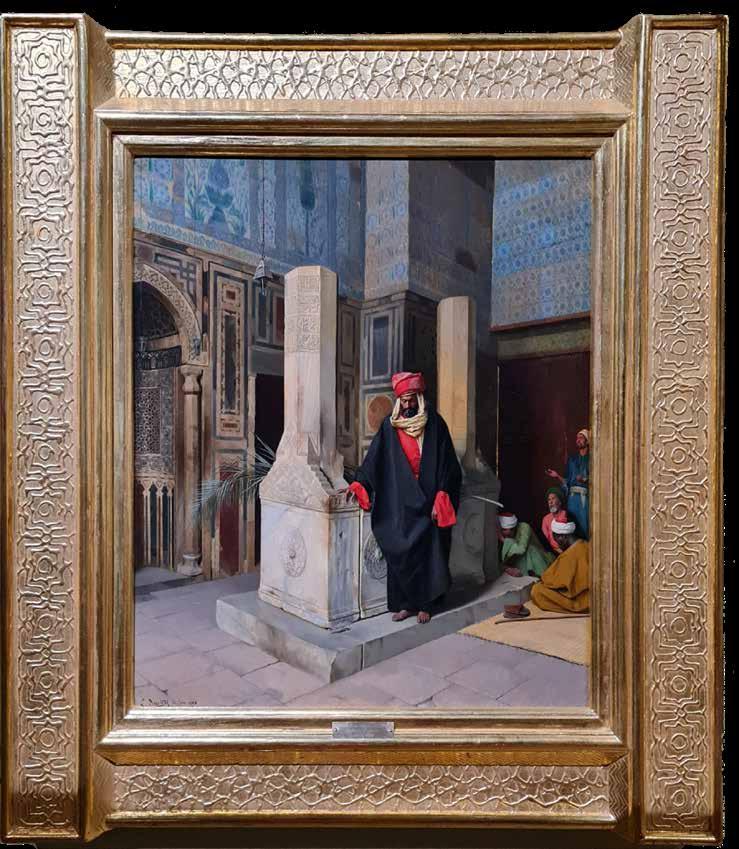
96
Praying In The Blue Mosque, Cairo, Ludwig Deutsch, 1898
The problem, it would seem, is that (Orientalist) artists are charged with misrepresenting those peoples and lands they have been painting, while continually perpetuating myths of a romantically ‘Utopian’ ‘Orient’ which might, or might not, be as real as the equally mythic Atlantis. Exotic, colourful, sensual are some of the adjectives hurled as abuse, somewhat unfairly, at ‘Orientalist’ paintings.
For some decades now I too have been charmed by many of the types of images gathered under that Orientalist/ism umbrella. My concern had been not how accurately those paintings had portrayed subject matter, culture or religion but whether I found images (like that of Frederic Leighton’s ‘Portions of the Interior of the Grand Mosque of Damascus’, 1873–1875, not featured in the Malaysian exhibition) aesthetically pleasing, or not. Hence me wanting to see this fresh exhibition on the subject of ‘Orientalist’ painters.
In my less knowledgeable days I hadn’t, of course, been aware of Leighton’s antipathy towards the term ‘Orientalist’ and its narrow confines. Nor of his pronouncing (in a letter to Eduard von Steinle, Thursday, September 3, 1857) that he was ...
“…shortly going to Africa, partly to make some landscape studies, but also to make acquaintance with that very interesting race, but not in order to become a painter of Bedouins”.3
That (Sun) day, at the museum, IAMM’s Nazir (Wan Muhammad Nazir Wan Nazahar) was very knowledgeable, and congenial, as he met with me at the museum’s foyer. He guided and eased me into the world(s) and histories of the artefacts on display in the exhibition ‘Orientalist Painters: Mirror or Mirage?’, at the Islamic Arts Museum, Malaysia. A better ‘guide’ I could not have wished for.
jewellery, featured in some of the presented ‘Orientalist’ paintings. Without Nazir’s help I would have, surely, floundered amidst the vast array of presenting material.
The verb ‘mirror’,according to the Cambridge Dictionary, means to “represent something honestly” or “to be very similar to something”.
The noun ‘mirage’ (also according to the Cambridge Dictionary) means “an image …of something that seems to be far away but does not really exist”.
In the weighty tome ‘Orientalist Paintings: Mirror or Mirage accompanying the exhibition of the same name Lucien de Guise reminds his readers that both words, mirror and mirage, are derived from the Latin ‘to wonder at’ and both carry with them some sense of distortion. (p15)
Thus the debate over ‘Orientalist Paintings’ asks if these creations are an accurate depiction of their subject matter, or a fantasy drawn from reality, but not reflecting reality. Of course Plato, in the Republic, agues that, at best, any kind of painting can only be a ‘copy’ (of reality), in fact it is even more of an illusion than is ordinary experience. In 1978 Edward Said (in ‘Orientalism’, mentioned above), was somewhat unkind when mentioning that..
“Orientalism is premised upon exteriority, that is, on the fact that the Orientalist, poet or scholar, makes the Orient speak, describes the Orient, renders its mysteries plain for and to the West. He is never concerned with the Orient except as the first cause of what he says. What he says and writes, by virtue of the fact that it is said or written, is meant to indicate that the Orientalist is outside the Orient, both as an existential and as a moral fact.”4
Nazir’s extensive knowledge revealed copious connections between painters, paintings and supportive artefacts, such as an actual (wall hung) carpet and (display case protected)
To be fair, in his book (Orientalism)5 Said does not mention the types or name of the artists seen in either of the recent exhibitions (London and Kuala Lumpur), but instead had pointed that
97
 Ushak Carpet, West Anatolia, late 16th C.
Ushak Carpet, West Anatolia, late 16th C.
 In the Mosque, Ludwig Deutsch, 1929
In the Mosque, Ludwig Deutsch, 1929
finger-in-movement at antiquarian artists like Piranesi, Delacroix “…and literally dozens of other French and British painters.”6
In modernity the debate continues, with scholars such as the aforementioned Anita Hosseini and, alternatively Walter Denny who had mentioned that one benefit of interest in Orientalist paintings is..
“ … the painstaking attention to detail manifested by some Orientalist painters, whose motives for this ‘realism’ were often highly complex, occasionally turns out to have interesting implications both for the history of art and for the history of taste, especially when works of Islamic art and architecture themselves form the subject of Orientalist paintings and prints.”7
Having seen the Kuala Lumpur exhibition, and gazed in awe at paintings like JeanLéon Gérôme’s ‘Rider and his Steed in the Desert’ (1872), and Charles Robertson’s ‘A Carpet Seller, Cairo’ where the viewer can easily identify the types of rugs on display in the painting (comprising of … Kazak Karatchop, Southwest Caucasus. Kuba Rug, East Caucasus. Triple medallion Kazak, Southwest Caucasus. Shakhrisabz Suzani, South Uzbekistan. Ladik prayer rug, Central Anatolia, and possibly a Southwest Persian rug8) I can therefore attest to Denny’s observation.
While the second (or is that the first) gallery is a smaller collection of paintings, it does set out the path for Orientalist Painting from Maghreb and Al-Andalus to Europe, Africa and Asia. It is a quiet gallery, but has in it paintings of such fervour and in such detail which draw the unaware eye into their scenes of wonder. As just mentioned, the detail is exquisite. The splendour of the artworks push aside any notion of inappropriate appropriation of culture, or culturally negatively affiliated mirage.
The visitor is presented with the wonder, not just of place and time, but of painterly skill and ability. Paintings like ‘Rabat’ (the red gate) by Edwin Lord Weeks (1879), and Edwin Lord Weeks (again) with his immaculately detailed ‘Entering The Mosque’ (1885), open portals for the visitor to step through or linger beside, astounded at the creator’s ability to depict such with their art. When auctioned by Sotheby’s (London) in 2019, the aforementioned ‘Rider and his Steed in the Desert’ by Jean-Léon Gérôme (1864), was described thusly…
“Painted in 1872, this evocative work captures the moment on a hot afternoon in the implacable brightness of the desert sun, as a horseman comforts his exhausted steed against the backdrop of a range of barren hills. With great mastery and a director's eye for narrative, Gérôme evokes the utter stillness and loneliness of the desert air. The heat is made almost palpable to the viewer through the bright sun on the rider's brilliant white headdress and dishdasha, and the sun reflecting off the horse's shiny coat.” 9
The first (or is that the second) gallery (on the higher floor, but which we visited first) was a full-on assault on the senses with its intimations of Victoriana (red walls), splendidly hung carpet (the actual carpet featured in Ludwig Deutsch’s painting ‘In the Mosque’ [1929]) and the life-size black and white photographs of artists in their studios. The latter had a convenient wooden bench in front, for those wishing just to stop and marvel, for a while.
The exhibition, overall, is a triumph and well worth not just a single, but perhaps multiple visits. I, for one, am certainly eager to see more of the Islamic Arts Museum Malaysia’s collection of ‘Orientalist Painters” when they become available. Ed.

100
Portraits of Power
Footnotes
1. Orientalism Edward W. Said, Vintage Books Edition, October 1979, Copyright © 1978 by Edward W. Said, Afterword copyright © 1994 by Edward W. Said.
2. Anita Hosseini, Published 13/01/2020, Updated 27/01/2020, https://bilderfahrzeuge.hypotheses.org/4553
3. The Life, Letters and Work of Frederic Leighton, by Mrs. Russell Barrington
4. Exhibition catalogue authored by Lucien de Guise, Edhem Eldem, Mary Kelly and Ali Nour, and published by IAMM, in Malaysia, 2022).
5. Quotations in and out of Context: Ottoman Turkish Art and European Orientalist Painting)
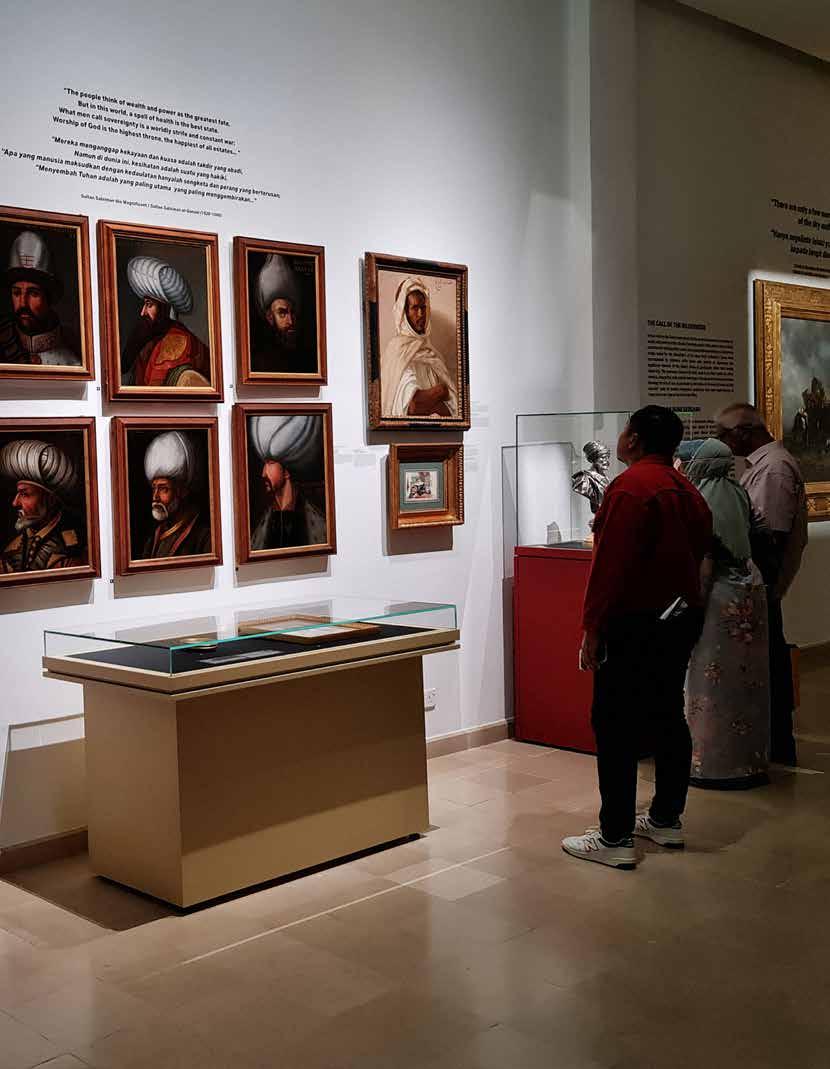
Walter B. Denny, Muqarnas Vol. 10, Essays in Honor of Oleg Grabar (1993), pp. 219-230 (12 pages)
Published By: Brill
6.Orientalism ibid
7. Walter Denny, Quotations in and out of Context: Ottoman Turkish Art and European Orientalist Painting
8.The Orientalist Sale, Sotherby’s, Lot 26, 30 April 2019 London.
9. Sotherby’s Lot 32, Important Works from the Najd Collection, 2019,London.
101
 Rider and his Steed in the Desert’ by Jean-Léon Gérôme, 1864.
Rider and his Steed in the Desert’ by Jean-Léon Gérôme, 1864.
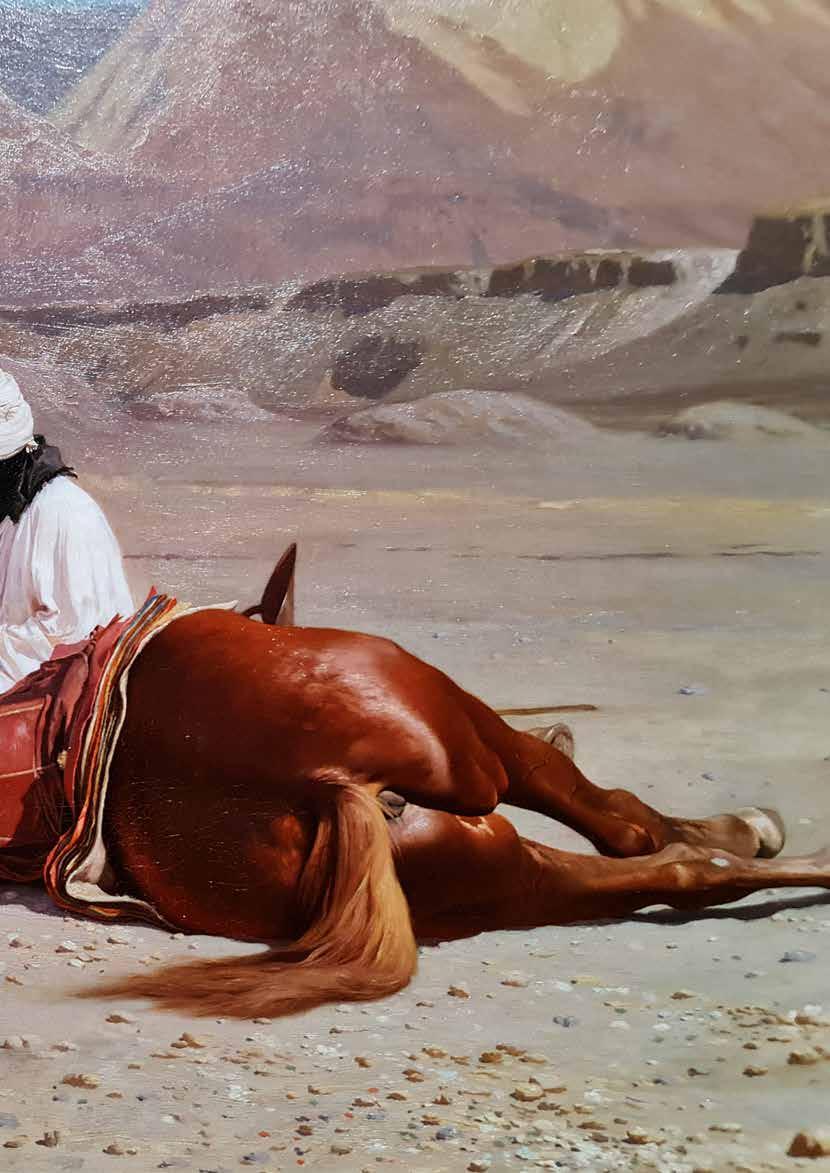
Cheong Kiet Cheng
The Last Star Before the Dawn
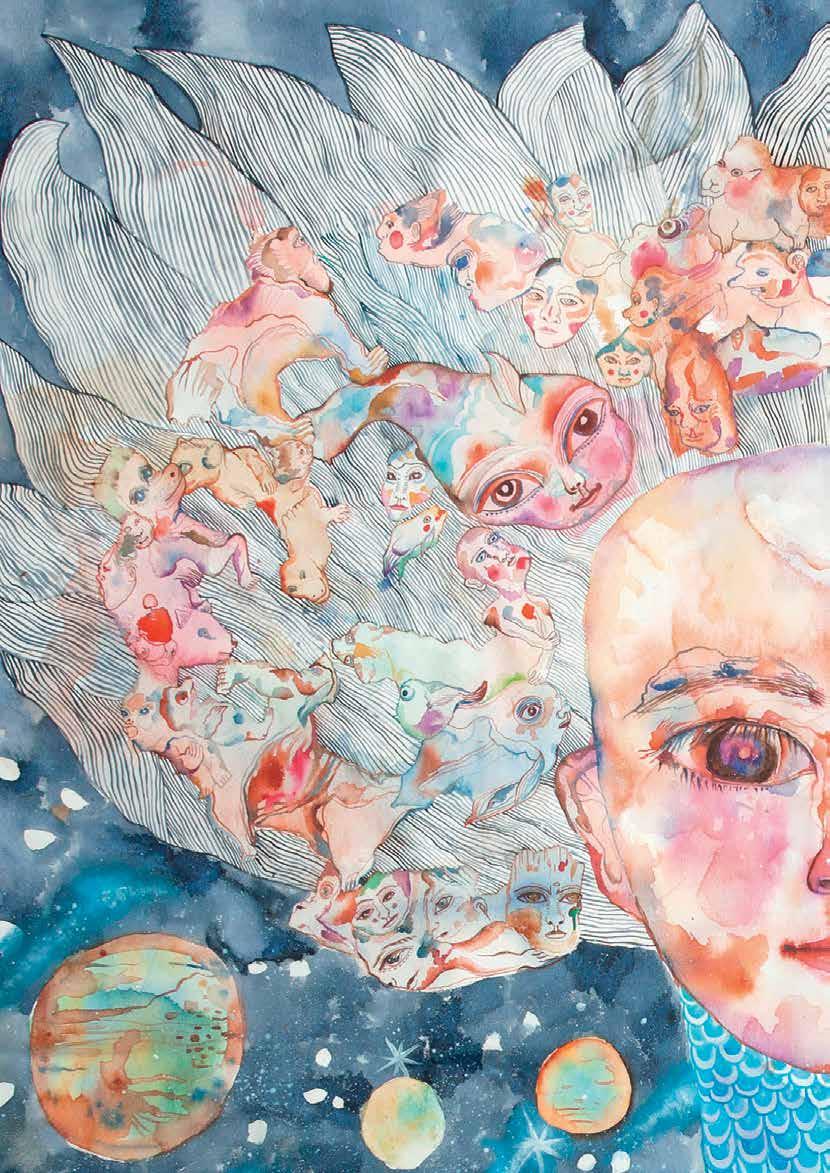


Cosmic wanderings
"I have been obsessed with the practice of tai chi for my whole life. When I am in the midst of practicing, people and things in my mind and in the world around me seem insignificant, as if they are floating in a vast sea of stars. As I move through the postures, it feels as if I am flying amongst the stars and everything around me fades away into emptiness".
106

107
Morning meeting
"Every morning now, I wake up at 5AM to get my daughter ready for school. Once she's off, I turn on my speaker and listen to music while I spend an hour meditating and watching the dawn sky outside. Although I miss the mornings of my childhood, when I woke up to the sound of birds singing and rode my bike through the misty woods, living in the city means that I must make do with what I have."

108
The Last Star Before the Dawn
Malaysian artist Cheong Kiet Cheng is known for her diverse range of mediums that she has used over the years. From oil to acrylic to ink to watercolour, Kiet Cheng has explored various mediums to express her artistic vision. In a statement, Kiet Cheng noted, “Each medium has its own unique qualities, and I enjoy experimenting with them to capture the essence of my ideas.“
In ‘The Last Star Before the Dawn‘ her highly anticipated fifth solo exhibition, Kiet Cheng showcases a collection of paintings created over a year and a half. This collection includes a batch of paintings created during the later stages of the epidemic spanning from 2022 to 2023. Inspired by the concept of enlightenment and the impermanence of all things, this exhibition invites viewers to contemplate the fleeting nature of existence and the idea that all things must eventually come to an end.
Kiet Cheng’s artistic process is grounded in daily life, and she incorporates lessons and ideas into her work. As she puts it, “There are always unseen hands that give me strength and guidance as I share my inner mysteries and elements.” Through her use of vibrant colours and intricate details, Cheng captures the beauty and fragility of life, encouraging visitors to reflect on their own journeys.
In keeping with her unique artistic vision, ‘The Last Star Before the Dawn‘ is a testament to Kiet Cheng’s ability to capture profound philosophical concepts through her art. This exhibition is a must-see for anyone seeking a moment of contemplation and reflection. As Kiet Cheng notes, “I hope that visitors will find a sense of peace and inspiration in my paintings and leave with a renewed appreciation for the beauty of the world around us.”
‘The Last Star Before the Dawn‘ is featured at Wei-Ling Gallery from 6 June – 8 July 2023.
Wei-Ling Gallery is located at No 8, Jalan Scott, Brickfields, 50470 Kuala Lumpur, Malaysia. Admission hours are Tuesday – Friday 10am – 6pm, Saturday 10am – 5pm.
Exhibition is open by appointment only. For appointments and further assistance, please contact +60322601106 or e-mail siewboon@ weiling-gallery.com
109
Twins Flowers
"In this arrangement, there is a sense of interconnectedness, where you and I are not separate but rather two parts of a greater whole. Like a drop of water in the ocean, we are small yet significant. Each individual is like a universe, experiencing both independence and a connection to the world around us."
"I feel the weight of the world's pain, and it can be overwhelming. But in that pain, there is also a sense of unity and shared experience. We are all part of this life, with its ups and downs, and we are all in it together."
110

111

112
The Mermaid’s Oath
"Mermaids are fascinating creatures. They are considered as the princesses of the sea, and when they dance and sing, it brings joy to all the creatures of the sea,including whales."
"In society, we are all like mermaids, unique and individual. The concept of a group is merely a construct of the mind. It is the individual that is truly alive and significant. Therefore, the key to living a fulfilling life is to embrace our individuality and strive to be the best version of ourselves."
113
The Last star before the dawn
"This piece was made as an imaginary letter to my husband."
"At the end of the Dharma, 2,500 years after the Buddha, chaos and chaos filled the world. I want you to keep your heart to yourself. Better than keeping everything safe.
The last morning star given to the subject. It is said that one morning after the Buddha meditated under the Bodhi tree for six days and nights, he gazed at a distant morning star. As the star slowly disappeared,everything in his mind gradually fell down, and then in an instant he was enlightened. When the last star has fallen, the world and all are put down. The works took a year and a half to complete. At the same time of each painting, I also meditate through daily life. Sometimes a lesson or idea comes to me, and I write it down and make it the subject of my painting. When the atmosphere of the big time, the influence of the world, perhaps everything is no longer important. Our ancestors, the masters of Ascension and the guiding Spirit, who helped guide us in the dark, always believed that everything was the best and necessary arrangement, no matter what situation we encountered. In the end, we always go back to the source. Everyone must go home."
114
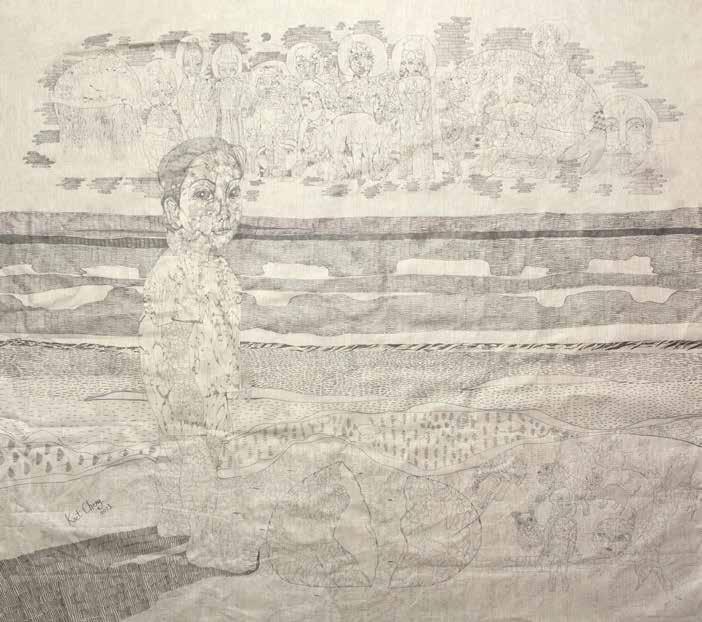
115

116
Creator and caregiver
"The painting explores the themes of creation and nurturing. It highlights that the source of life and the nourishment of life are derived from the same energy, which is as soft and strong as a woman. Life gives silently, without uttering a word, and we receive and consume.
Additionally, the story behind the painting mentions the five planets which represent the five elements: Mercury, Jupiter, Mars,Saturn, and Venus. These planets were created by the creator, God."

117
Mohammad Ferdous Khan Shawon
118
Colour Plate

119
Composition
The works of Ferdous Khan are emblematic of the course of a young artist. The love of art can be traced back to infancy; the birds, the characteristic boats of Bangladesh, the still lifes, all indicate a particular attention towards the environment and a precocious sensitivity for nature expounded from an early ability to aesthetic quality, and why not, an initial but notable quality of colour. It is from this point that the sense of the graphic works emerge, where the natural elements, the sun, the trees, the women, the fishes, the tigers, are all recounted with such a strong sense of joy and freshness that it would seem to derive exactly from childhood.
Research, as it should always be, enriches and accompanies Ferdous’ artistic career and influences the second phase of his works. Clive Bell’s aesthetic theory directs him towards the abstract. Strong compositions of colour, where movement and energy become the dominant theme of the work, together with an oriental sensibility, all harmoniously and elegantly expressed. The brightly coloured backgrounds indicate a strong independence from the undisputed artists who appear to have influenced his work, see Pollock and Rothko: in any case, the structure of the work is more distanced, the “earth quaked” nature expands and stretches, it inclines towards the oriental culture assuming its own, precise specificity.

120
Composition
It also contains the influence of the oriental miniatures, the suave elegance of the Moghul period, that sense of timelessness in the description of something ordinary that assumes a precious and fairy-tale atmosphere.
All of the preceding elements blend and amalgamate leading to artistic maturity and more mature works that have transformed the dream and enchantment of childhood into a new and contemporary awareness tied to the concepts of history and society.
Coming from an objectively difficult country, Ferdous emphasizes and resembles everything permissible to build a modern, progressive social identity. Lo and behold the related works of the bloody and dramatic war of independence so suffered and venerated in Bangladesh: apparently simple elements describe the tension of the conflict and aspiration to freedom; the women who refused to sneak away and leave the fighting to the men, which is what usually happens, the feminine figure, cut out from a newspaper to document the actuality of history, who takes the machine

121

122 Composition
gun from the soldier’s hands, is neither dramatic nor disquieting but positive and serene in the knowledge she is carrying out her duty. Ferdous continued using cut-outs from newspapers to create linear, substantive collages, though nothing is left to chance, as his works always deal with absolutely necessary current social themes. He puts forward work concerning the environmental conservation and the colours assume bright, sunny meanings, the fish of his childhood are darting and flashing with life, the birds could be planes, the cobalt blue skies are aglow with light.
When he proposes works concerning birth control, there is always a sense of happiness and unity in the figures of the children and parents, represented in the background of a serene, illuminated world, alight with tropical lights. The movement suggests dancing, and the flat figures become a part of the coloured background. If he deals with the problem of food-relief or pollution, there is always this light-airy feeling about things, an abnormal, poetical lightness even though it is within such dramatic themes, it is as though he wants to offer us a positive glimpse of the future because these light figures, cut from pages of daily newspapers, which are nothing more than places of horror and fear. It is as though they have been dragged into a natural, or maybe even cosmic reality that penetrates and claims us, donating us the energy of his brilliant colours and his clear, strong lights to help us overcome and fight the emergency and urban decay.
Patrizia Molinari Professor, The Academy of Fine Arts of Frosinone, Italy November 2008
123
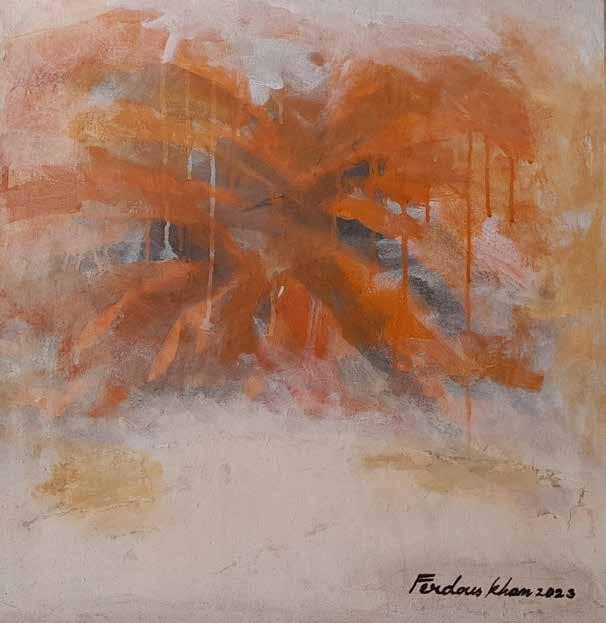
124
Ray of Hope

125
Gloves
1
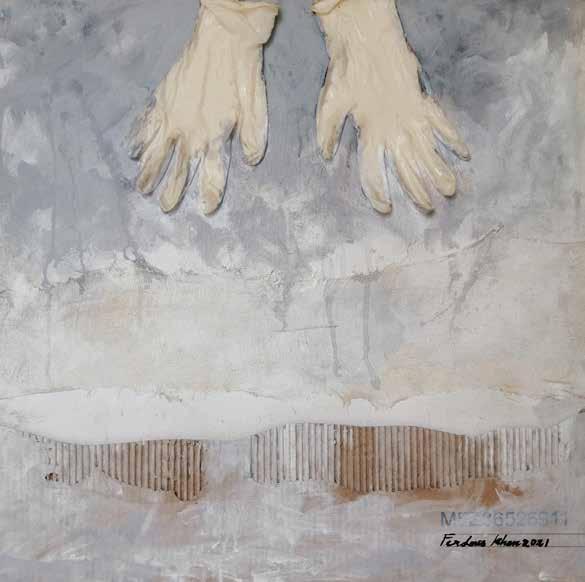
126
Gloves 2
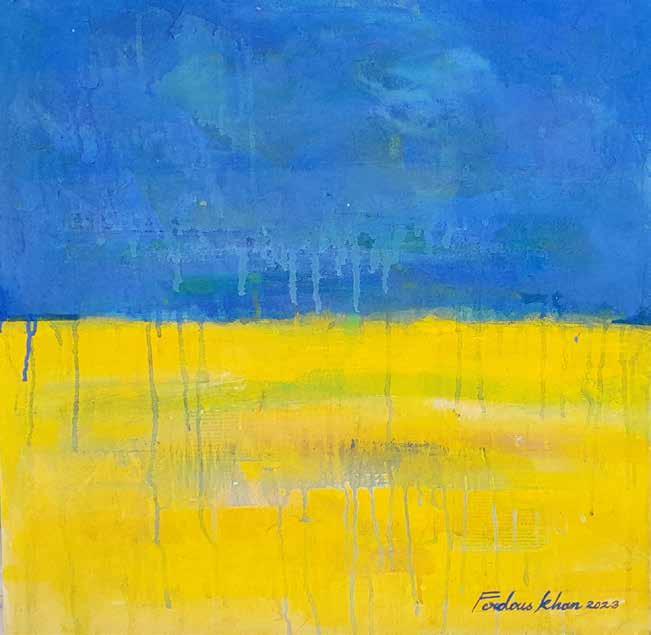
127
Ukraine

 Bono Stellar, (art installation)Theta
Bono Stellar, (art installation)Theta
Malaysia’s National Art Gallery
The historical establishment of the National Art Gallery (BSLN) was the result of the initiation of idea mooted between 1954 and 1956 by the Malaya Arts Council, helmed by the late Tan Sri Mubin Sheppard and Frank Sullivan. According to the 1974-1975 BSLN Annual Report and the 1979 National Art Museum Annual Report, the BSLN Board of Trustees was formed on 3 June 1958. On 27 August 1958, a two-storey building at No. 109, Jalan Ampang, Kuala Lumpur, adjacent to Malaysia’s first parliament building (then known as the Federation of Malaya), was officially allocated by the government to the National Art Gallery. The ordinance to establish the BSLN Board of Trustees was given the royal assent by the Yang diPertuan Agong in 1959 through Act 516: National Art Gallery Act 1959.
The establishment and official launching of the National Art Gallery was officiated by the incumbent Prime Minister then, who was also the first Prime Minister of Malaysia, YTM Tunku Abdul Rahman Putra Al-Haj. The launch coincided with the gallery’s maiden exhibition at the Tunku Abdul Rahman Hall, participated by local artists from all over the country as a manifestation of their spirit of unity and solidarity through their artwork. Indeed, the establishment of National Art Gallery was recognition by the government towards the national arts.
Frank Sullivan was appointed as the first administrator of the National Art Gallery. Being the former secretary to Tunku Abdul Rahman Putra Al-Haj, he held a concurrent position as the Secretary of the BSLN Board of Trustees until 1970. On 28 January 1987, a ground breaking ceremony for a new building of the National Art Gallery was held at a site in Jalan Tun Razak, Kuala Lumpur. The construction of the new building was done through a privatisation project between the Government of Malaysia and Yeoh Tiong Lay (YTL) Company. It was completed in 1998.
On 13 November 1998, the National Art Gallery (BSLN) moved to its own building at No. 2, Jalan Temerloh, Off Jalan Tun Razak, Kuala Lumpur in concurrence with the launch of the 13th Asian International Art Exhibition. The new National Art Gallery building was officially opened by YAB Dato’ Seri Dr. Mahathir bin Mohamad (now Tun) on 27 September 2000..
Open every day starting 9.00 AM – 5.00 PM (Last Visit 4.00 PM)
Address Lembaga Pembangunan Seni Visual Negara, No. 2, Jalan Temerloh, Off Jalan Tun Razak, 53200 Kuala Lumpur
Phone / Fax +60 3-4026 7000 / 03-4025 4987
129
SEARCHING FOR THE ESSENCE
The New Economic Policy (NEP) and MAGERAN were established as the tools for reconciliation and recovery for the multi-racial Malaysian society and its economic plans after the unfortunate tragedy of the 1969 racial riot. The national cultural identity was debated at the National Cultural Congress to find a meeting point for various fields that include art (1971) now, followed by Ministry of Tourism, Arts and Culture Malaysia initiative in 2021 to launch a revised National Cultural Policy (DAKEN).
The essence sought is to work based on the society's perspective of a new MALAYSIA. After the dark events of the 60s, the transition and journey towards becoming a new matured nation had to undergo several vital phases that involved diplomatic processes, politics, new economic plans, and the strengthening of a multiracial society. It is integrated with all aspects related to race, language, ethnicity and religion, under the banner of Jalur Gemilang, Rukun Negara, democratic system and elective constitutional monarchy.
For thousands of years, we have been experiencing the syncretism process that saw the assimilation of ideas, cultures, traditions and beliefs. Matters concerning race, religion and culture were brought to light by the vision and perspective of modern artists in the country. Although there were efforts to find and bring forth the essences of local identities, we cannot

deny the penetration of foreign cultures in our cities due to massive cultural integration - Malay, Chinese, Indian, European and American. The tropical natural landscapes that looked peaceful hide the actual narratives; the modern pictorial chaos that swept the country in search of identity.
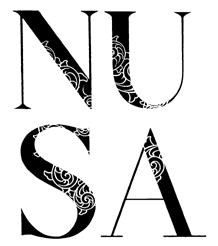
130
Bayu Utomo Radjikin, Bujang Berani

131
Tan Wei Kheng, Kenyah Woman

132

133
Roslisham Ismail (Ise) Place of Unity
 Victor Chin (Chin Choong Seng), 241 Beach Road, Singapore
Victor Chin (Chin Choong Seng), 241 Beach Road, Singapore
EXPLORING STORIES
Exploring Stories represents the earliest visual documentation in the form of sketches and watercolour works by expatriates that are in the national permanent collection. The visual documentation of their expedition through the rivers, jungles, mountains and villages, sketching portraits, activities and the surroundings, is represented as a rare collection of the 18th century. The natural landscape and daily activities in Malaya have become important subject matters in their paintings or memorabilia that carry a sense of nostalgia.
The daily activities in the landscapes of Peninsula Malaya and Borneo Islands are captured in the documentary "Footsteps of Malaya, Malay Sketches, London Illustrated News' that was produced by British-Deutsch administrative officers during the colonial period (news of the lands of Malaya, Borneo and the world of Asia) and reached all corners of the east-west continents. Sketches highlighted in the documentary are of pencil, ink and watercolour medium on paper made by Sir Frank Swettenham, George Giles (Federal Territories - Selangor, Perak, Negeri Sembilan and Pahang), William Daniel (Southern region - Penang) and William Samwell (Borneo islands, Thailand).
For the early younger generation who travelled to Europe in the 1960's, the period of their journey in search of art knowledge was filled with a sense of longing for the things left behind parents, families and homeland. Reminiscing the beauty of the tropical land, its people and culture, they have somewhat become nostalgic for a temporary period of time.
This includes the group of artists from China who migrated to and settled in Malaya/ Singapore and later known as the Nanyang Artists. The Nanyang style is a combination of Chinese painting and European modern art. The integration of lifestyles in the Southern Sea had created this style presenting the subjects of the local tropical world and adapted by many young artists in Malaya and Singapore.

135
All text
from official sources.
Ed.
taken
Photos by
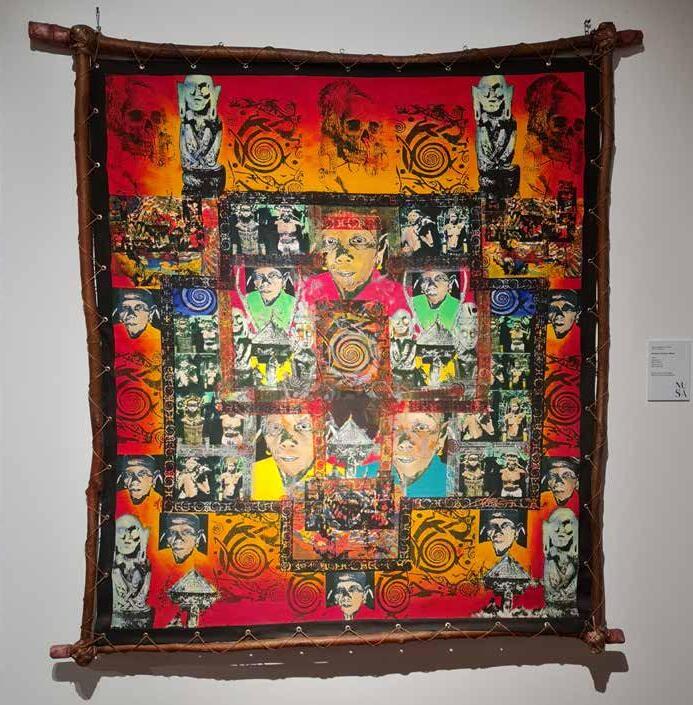
136
Kelvin Chap Kok Leong, Belawing Keramen Mamat
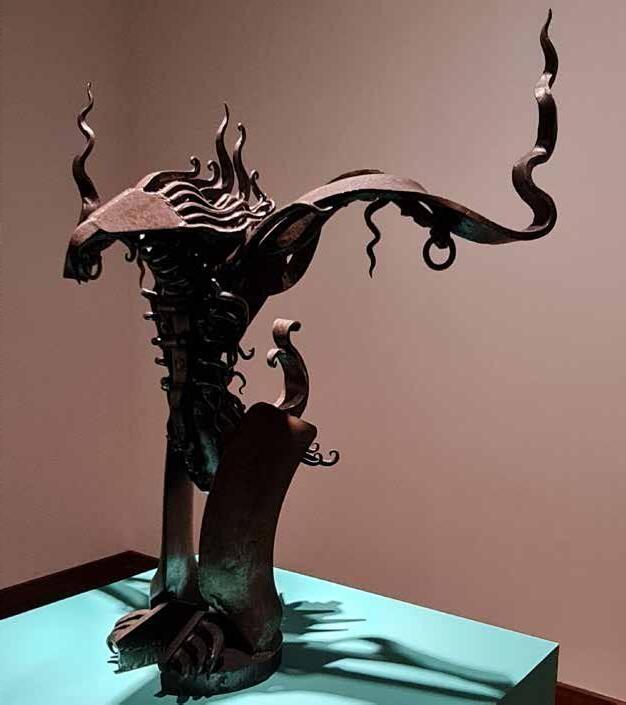
137
Raja Shahriman Raja Aziddin, Sang Rajawali

138

139
Zulkifli Yusoff, Sarang Tebuan Jangan Dijolok

140
Snake Two @ Muhammad Abqari bi Ahmed Shakri, Migration

141
Texts taken from the exhibition NUSA at the Malaysian National Art Gallery (BSLN), Kuala Lumpur.
Sacha Inchi
Chock-full of Omega 3
It appears to be a truism that knowledge and education come from unexpected sources, and at unexpected times.
Until recently I had absolutely no idea what a ‘Sacha Inchi’ was. It could have been a new fusion band, an obscure (to me) member of the literati or a newly discovered destination. It turned out to be none of those things.
Only recently I had met up with a Malaysian gentleman who farms, one Mr Chee Tack Kong. It was then, and only then that I began learning about an important 'Superfood', from Peru but now grown in Malaysia. It is called Sacha Inchi.
One of its big selling points seems to be that it is chock-full of Omega 3 fats (frequently found in fish) and has been shown to help prevent heart disease/stroke, help control lupus, eczema, rheumatoid arthritis, and play protective roles in cancer and conditions like diabetes. I'm learning more, but I was very impressed with the nutty tasting salad oil, and the very tea tasting (noncaffeine) tea
Sacha Inchi (aka Plukenetia volubilis Linneo, or in the native Quechua language false [sacha] peanut [inchi]) is, simply put, a nut. Its other names (according to Wikipedia), are sacha peanut, mountain peanut, Inca nut or Incapeanut. The name ‘Inca’ gives a good clue to its origins in the tropical rainforests of the Amazon region of South America, the Peruvian jungle, Ecuador and north-western Brazil. That is where this intriguing plant has been cultivated for centuries (Food Chemistry, Volume 373, 2022).
Since, in fact, pre-Inca times in the Chanka and Mochica-Chimú indigenous tribes (Food Technology & Biotechnology. 2021 Sep; 59(3): 253–266).
In the West, Sacha Inchi is rapidly becoming acknowledged as one of the ‘superfoods’ originating from South (or Meso) America. These ‘superfoods’ are defined by the MerriamWebster Dictionary as being “rich in compounds (such as antioxidants, fibre, or fatty acids) considered beneficial to a person's health”. The ‘superfoods’ category also contains consumables such as Maca root, Chia seeds, Spirulina, and Cacao, as well as including curiosities like ‘Purple Corn’ (used in highly coloured drinks, and hailing from Peru, Ecuador, Bolivia, and Argentina). Then there is ‘Aguaje’ a fruit, again from Brazil, Ecuador, Peru, as well as Bolivia; and Camu Camu (a berry) from Peru, and Brazil, as well as Lucuma, a fruit from Peru, Bolivia, and Ecuador. The now-called ‘superfoods’ are, in actuality, ancestral pre-Colombian constituents of authentic Mesoamerican diets.
Sacha Inchi, to say the least, is no ordinary nut. For one, its extremely tough skin bravely resists attempts at ingress but, once opened, the seeds have generally been roasted and the leaves cooked and consumed or made into a caffeinefree tea, down the mesoamerican generations. In modernity ‘Healthline’ (https://www. healthline.com/nutrition/what-is-sacha-inchi) suggests that the nut is “incredibly versatile and can be used whole and roasted, ground into a powder, or pressed into oil. Thus, you can add them to recipes, enjoy them as a snack,
142

143
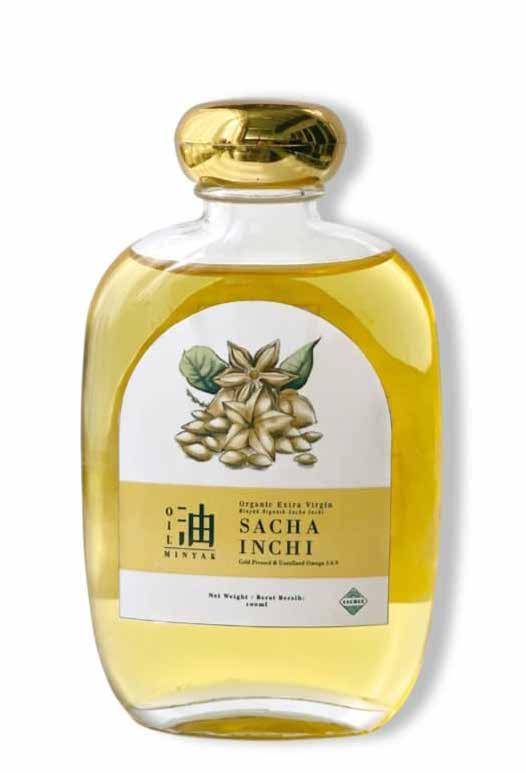
144
or incorporate them into smoothies and baked goods.” The ‘pressing into oil’ is performed as a cold-pressing process whereby the Sacha Inchi nuts are gently pre-warmed to the press temperature and then fed into a screw press. The resulting products are Sacha Inchi oil and Sacha Inchi press cake, which undergoes further processing.
Sacha Inchi ‘tea’, roasted nuts, oil (for salads) and soft gel oil (for health) are currently available in Malaysia, through the brand ‘Sachee’, and available from Sacha Inchi Superfood Sdn Bhd [202001033851 (1390172-M) Lot 2812, Mum Pilah, 72000 Kuala Pilah, Negeri Sembilan Darul Khusus, Malaysia.

 Ed.
Ed.
Telephone
+6010 709 1335 or
+6012 303 6869
Website www.sacheesuperfood.com
Email enquiry@sacheesuperfood.com
145
On Malaysia’s State election day, August 2023, we visited the, now forgotten, Chinese ‘New Village’ (Kampong Baru) of Kampong Kalumpang, at Kering, vaguely adjacent to the town of Tanjung Malim.
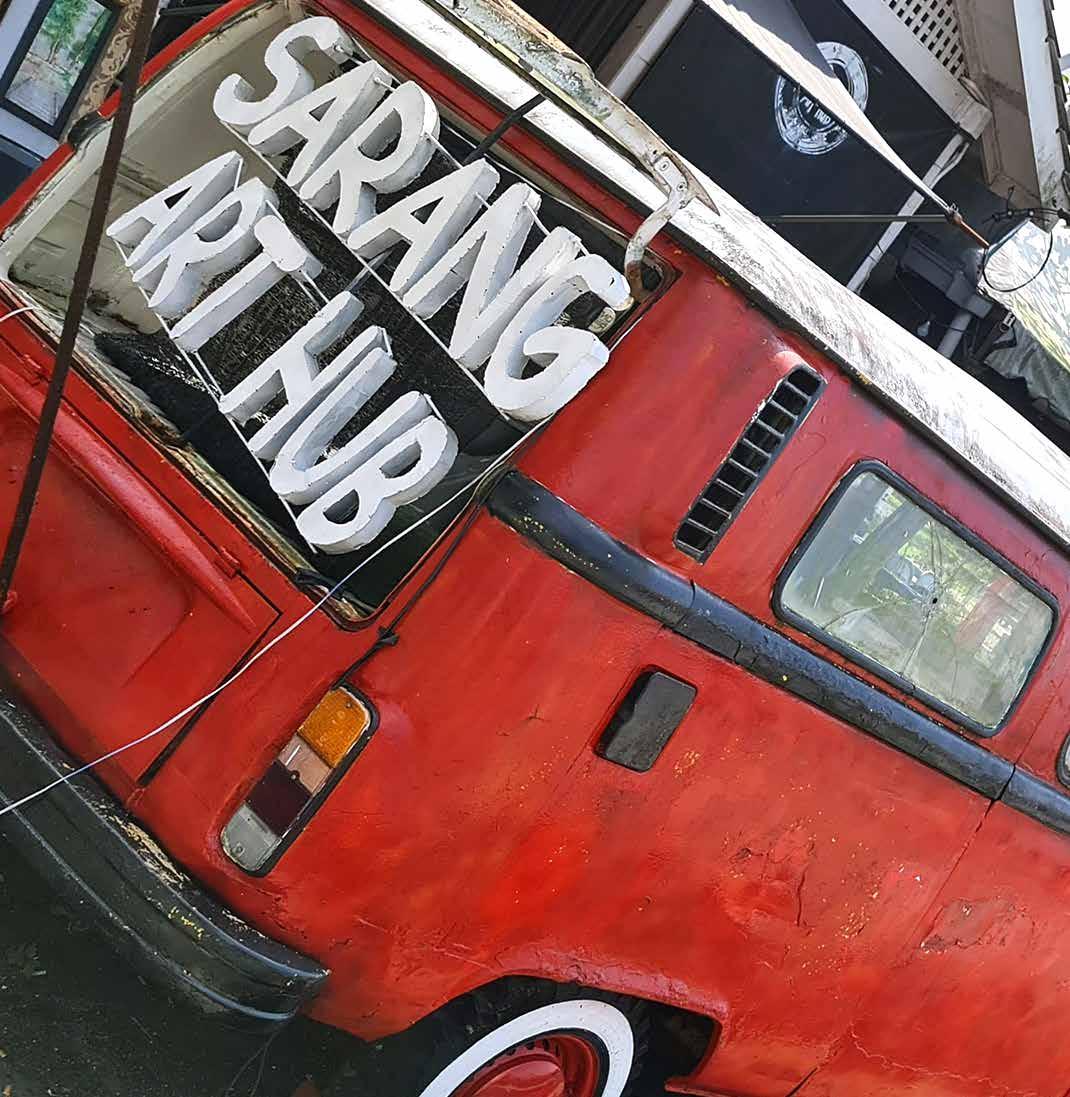
Down narrow streets we edged, under a leaden sky until we saw the impressive Arulmigu Sri Maha Sivasakthi Mariamman Devasthanam (an Indian temple constructed to service the Indian community back in the days of British
colonialism, and rubber plantations ). It was nestled between a run-down ‘wet’ market and quietly ageing houses. At that brightly painted ‘Murugan’ temple we had gazed in awe at statues and wallowed in the ambience while speaking, briefly, to the attendant priest. Later, on that adventurous day, we took ourselves off to the Inki River Park, to watch brightly coloured butterflies (and local inhabitants bar-b-cueing) by the river (Sungai Inki).
146
All that culture and nascent homogeneity only fostered a distinct craving for coffee. Any kind of coffee that is, albeit the local ‘Robusta’ which desperately needs the accompanying condensed milk (aka palm oil based sweetener) or the universal standard American ‘Starbucks’ mix of Robusta and Arabica. We therefore took ourselves off to what appeared to be a partially closed Tanjung Malim. That town had, originally, been a Bugis settlement with settlers from Sulawesi, Indonesia, arriving in the Malay
peninsula during the 16th century. Tanjung Malim has since developed into a small(ish) township, mainly servicing the nearby universities tucked away on the borders of Malaysia’s Selangor and Perak states.
Wherefore art the ‘Art Hub’, I hear you ask. Good question.
Once upon a time, way back in 2010, when this editor was living in rural Perak (Malaysia) I

147

148

149

150

151

152
met and created an article about the local film director Mamat Khalid (Mohamad bin Mohamad Khalid), brother to the Malaysian cartoonist Datuk Mohammad Nor bin Mohammad Khalid (aka LAT). This is an excerpt….
“The Malaysian film director - Mamat Khalid sat opposite me and grinned a huge, welcoming, boyish grin. There was a distinct twinkle in his eye as he spoke of his films and film making. Mamat has a, seemingly, undying passion for his craft and filmmaking as a subject, has fascinated him practically all his life.
With great gusto Mamat explained his fondness for film, his appreciation of the Monty Python team and for the comedies of Mel Brookes – echoes of which are evident in Mamat’s latest film - Hantu Kak Limah Balik Rumah (Sister Limah’s Ghost Returns Home2010).
Hantu Kak Limah Balik Rumah is a slight return to Kampong Pisang (Banana Village) where zombies overran the villagers in Mamat’s - Zombi Kampong Pisang (Zombies of Banana Village -) three years
earlier (2007). To date ‘Zombi’ remains the best loved of all of Mamat’s films, along with all its cultural and film references. “
Mamat Khalid was responsible for the Sarang Art Hub, a place for art activists and the community to gather. It was located at a ‘Rest House’ (Rumah Rehat) at Tanjung Malim. Events were organised there, film talks and music too, not to mention visual art, wall art and graffiti too. The Sarang Art Hub was a haven, evidently, for lovers of art to enjoy later in the day and, maybe, into the morning too. Meals reflected the influence of the director, and were named after some of his most iconic films like ‘Kampong Pisang Fried Rice’, named after Khalid’s ‘Zombi Kampong Pisang’ (2007).
Sadly, Mamat Khalid died at the Slim River Hospital, on 24 October 2021, at the age of 58, due to heart disease. He had collapsed at his Sarang Art Hub restaurant in Tanjung Malim, and was buried at the Masjid Paloh Muslim Cemetery in Ipoh, Perak, Malaysia.
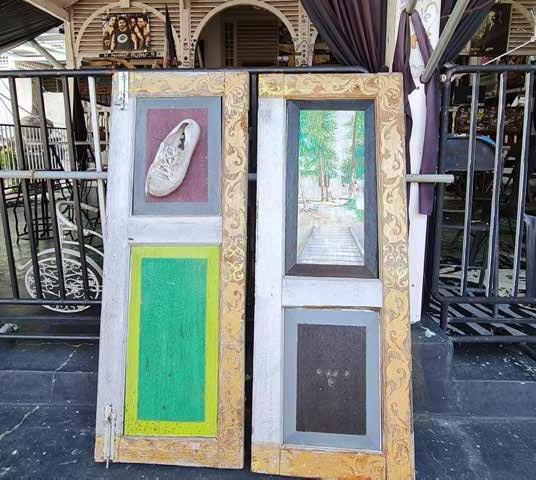
153
Ed
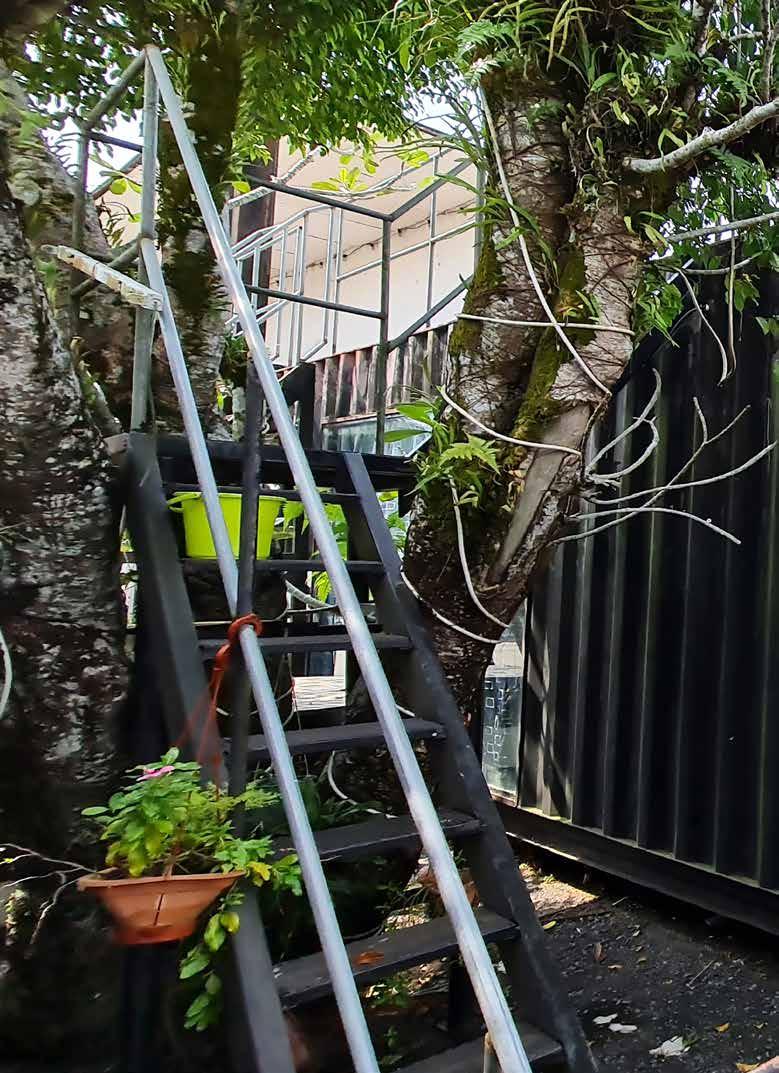
154

155

Diptych (part)
chang fee ming

chang fee ming
Born in 1959 in a rural coastal town in East Malaysia, the self-taught Chang Fee Ming is one of the foremost artists today working in the watercolour medium in Asia. Celebrated for his extraordinary grasp of texture and light and for the orchestration of vibrant colours in his paintings of life in idyllic rural scenes, he is not only a watercolourist extraordinaire, but also an incisive and sensitive observer of society, culture and history.
158
Once upon a time in Terengganu

159

160
Souls of the sea Sabah
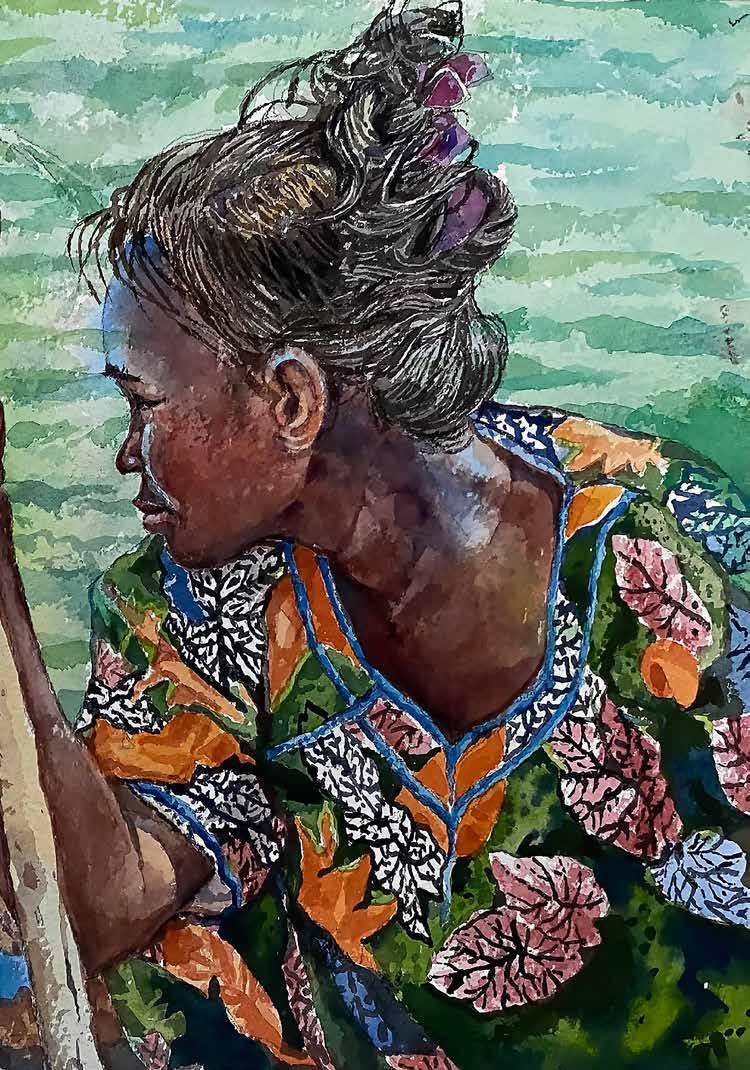
161
His reward

162

163

164

165
Taman Mini Indonesia

166
Mangosteen Sumatra
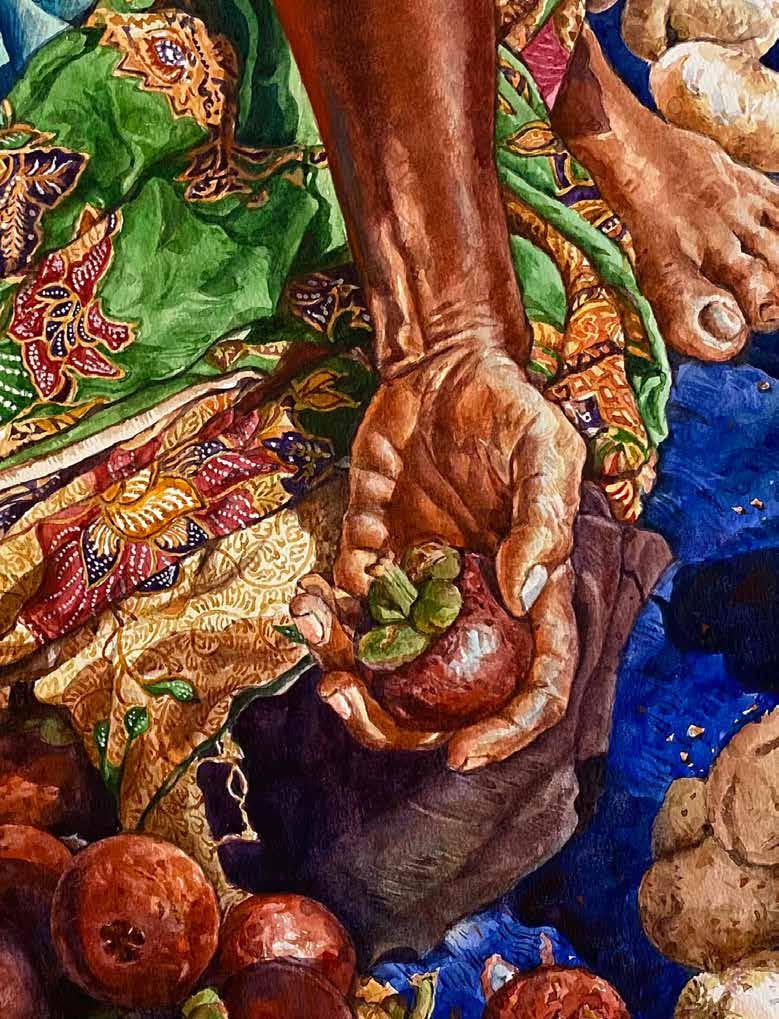
167
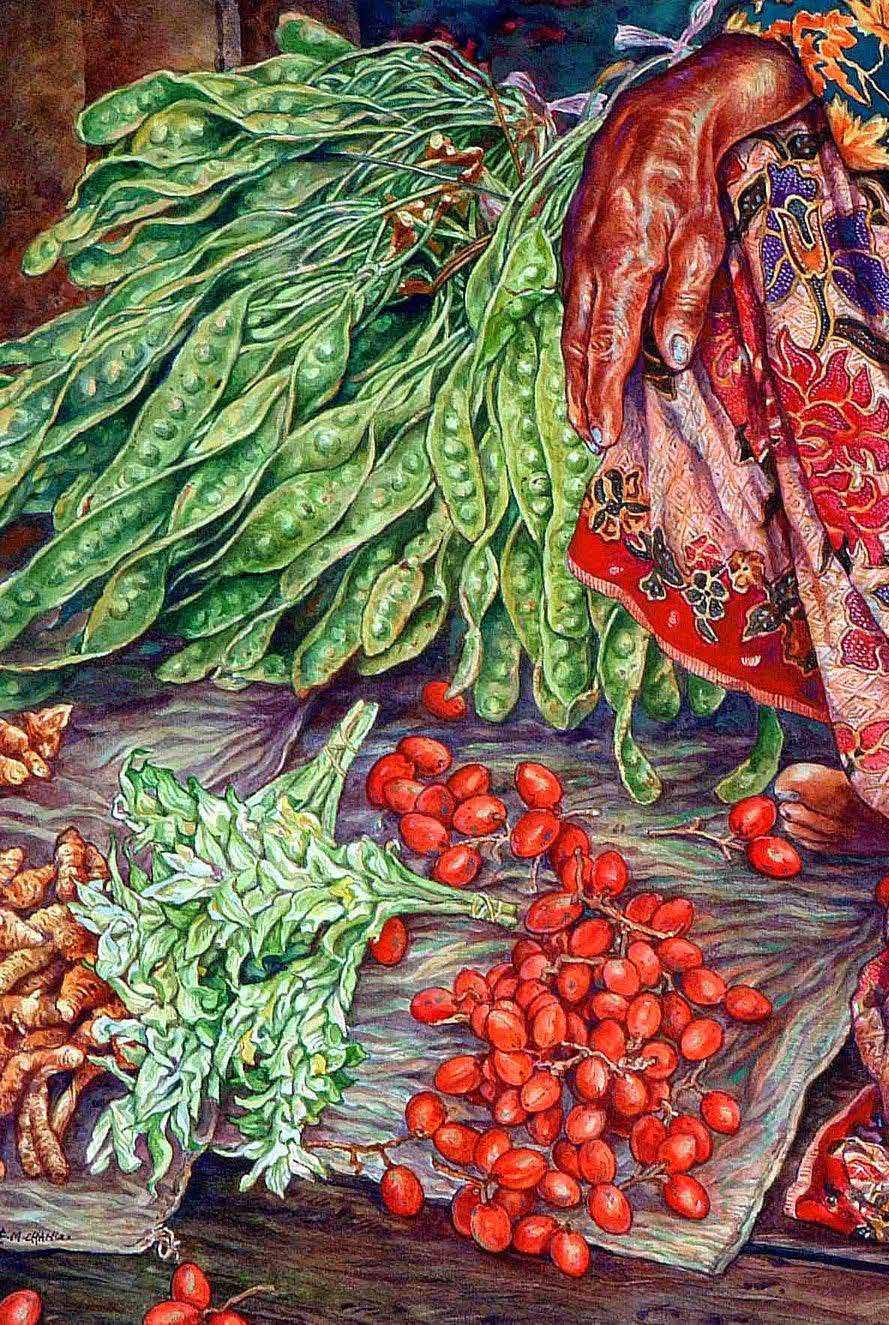
168
Once upon a time in terengganu
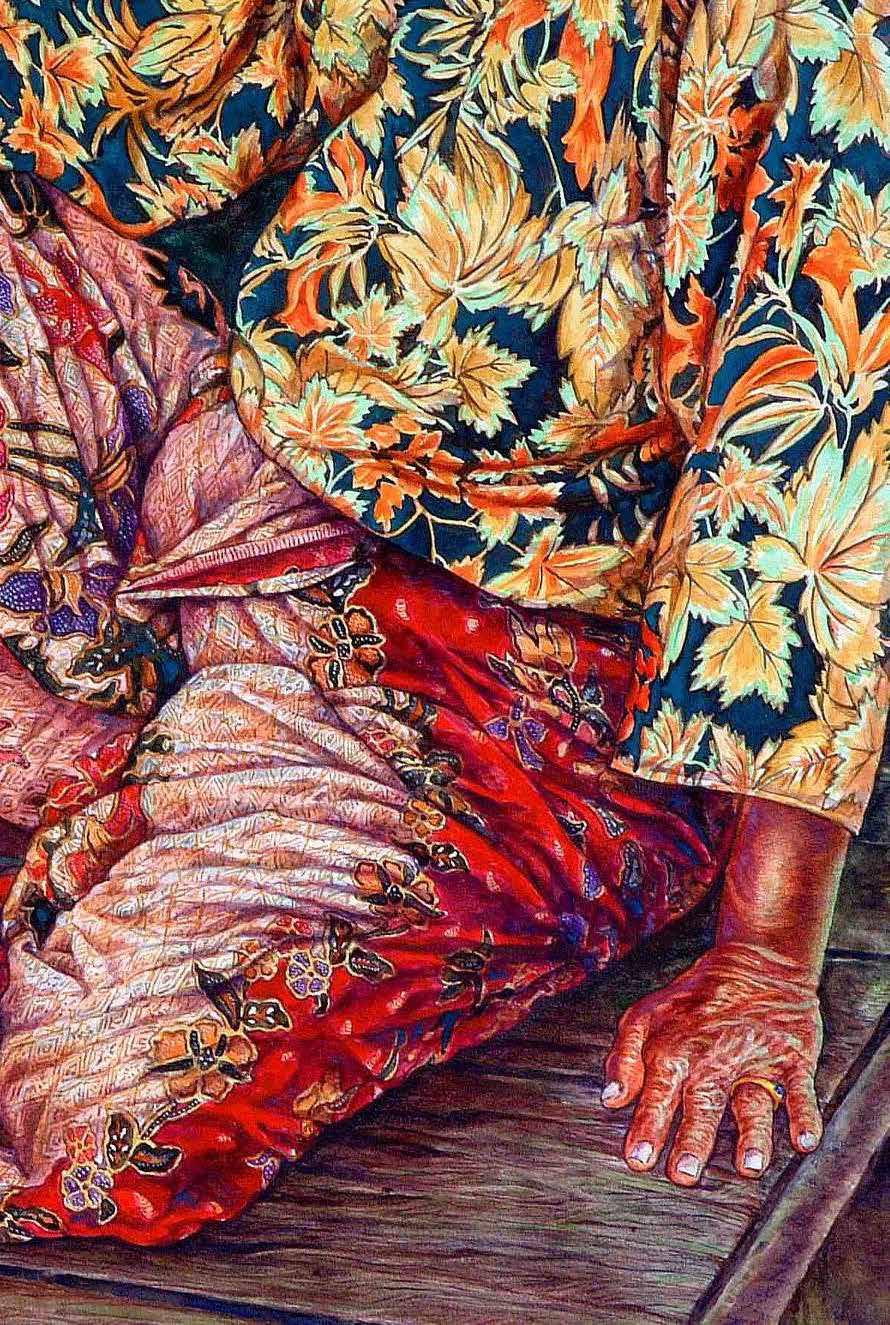
169

170
Painting of the week- 31 October 2018
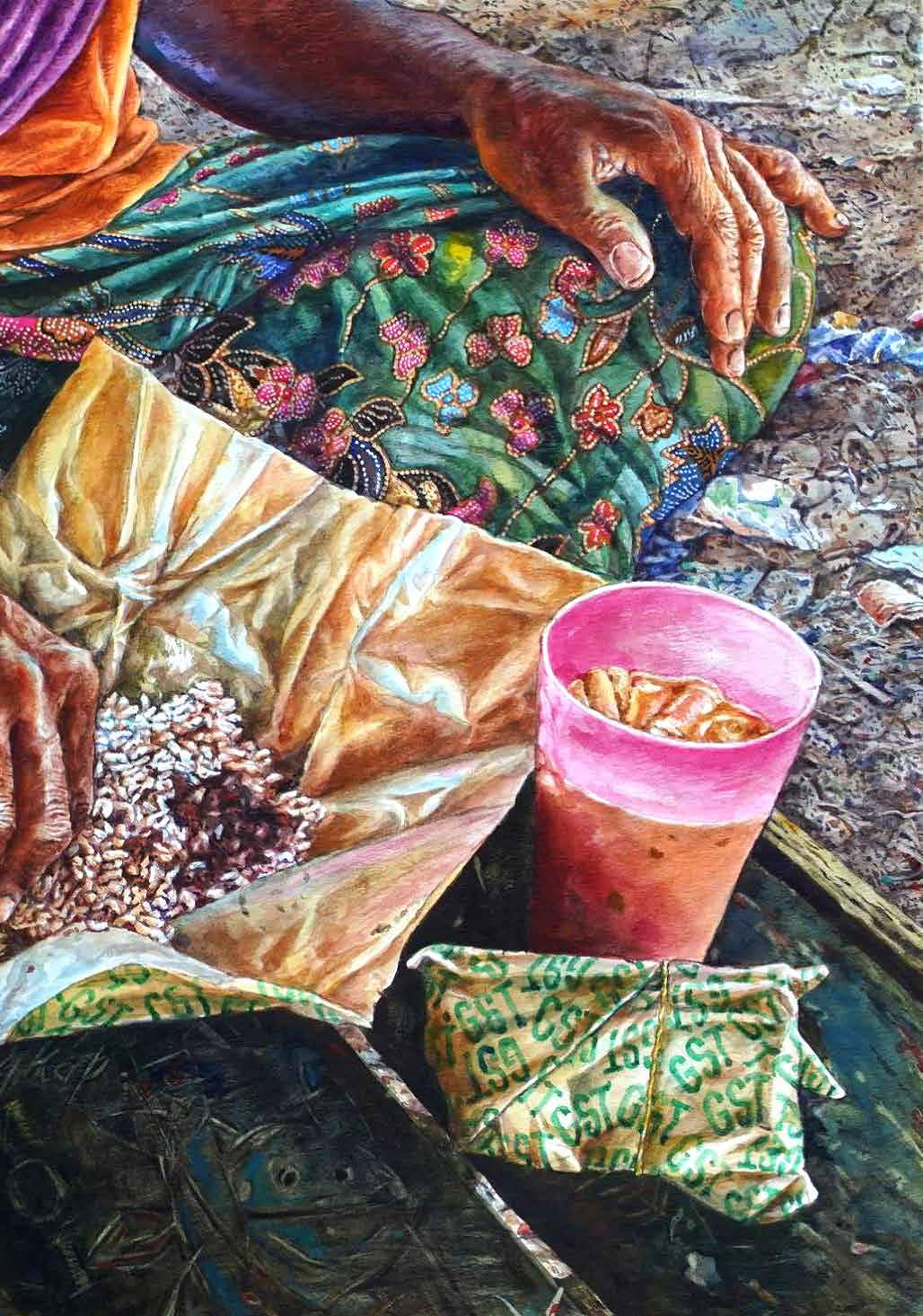
171
Cooked to Perfection

The Individually Mentally Challenged (IMC),Training Centre for ‘Special Needs’ still has the remains of a restaurant training programme, in Puchong, Malaysia.
Its continuing aim is in assisting young people with 'Special Needs' (Autism et al) in working within a professional restaurant environment, by having a “purpose built training centre for children & individuals with Special Needs”, the sister programme to one at Subang Jaya.
On the rainy Friday that I visited what had been known as the ‘Pestle & Mortar Curry Place’ before Covid 19 struck, a group of seventeen young special needs young adults had come together out of the gloomy rain, in a Puchong shop lot, to learn the bare essentials of functioning within a working restaurant environment.
Contrary to popular belief concerning people with special needs, there was no rowdiness, or disruption. Instead the 'students' of differing
races donned their work aprons, and then sat awaiting instructions from ‘Mrs Sunny’ (aka Raaginee Shalesh), who was very much in charge (in a motherly way), and was accompanied by her two hard-working assistants.
In 2021 (in ‘Sanctuary for special needs kids, adults with behavioural issues’, by Dharshini Ganeson, The Vibes.Com) Raaginee is quoted as saying..
“
All these children and adults with special needs must be trained to lead independent lives, and I have set up a restaurant for them to work at and gain experience so they can earn a living in the long run.”
After the Covid 19 pandemic, the restaurant has, sadly, closed. But there is still hope. This batch of ‘students’ look very promising however, due to the enormity of the challenges before them, the attendees had to be guided in everything, from the cleanliness of their fingernails to the (restaurant) appropriateness of their attire,
172
as well as in the overall restaurant/kitchen preparations and the cutting and production of the meal.
On that day, the young adults were separated into functional groups with each group having its own task, while some students assisted in a general manner. That day’s main tasks were food preparation (prep), creating the necessary cut ingredients for ‘sweet and sour fish’, ‘nasi lemak’ (essentially coconut milk rice) and two vegetable dishes as well. One group had been tasked with the cutting of the vegetables, carrot, ginger, garlic, onion etc for the two dishes, while another prepared the rice.
It was a slow process but the group, overall, succeeded in getting the meal ready in time. Although the young people had higher functioning 'Special Needs', they nevertheless required to be shown what to do. One young man was able to cut ginger and garlic, in a very slow fashion, but literally needed his hand holding
to do so. When it came to coating fish with a turmeric based marinade, the young people each took turn to spoon the thick substance over silvery fish.

A group of three people were set aside to deep-fry the fish in the industrial sized kitchen. There was a small mishap. Hot oil splashed on an attendee. It was, to all intents and purposes, a minor accident with one staff member instantly attending to the mildly injured hand. After enough attention had been gained, the young burn victim was up-andabout relatively unscathed. The fish, however, was cooked to perfection.
I was also treated to the meal. And it was delicious.
Ed.
173
Sweet and sour fish
Martin Bradley
Martin Bradley is the author of a collection of poetryRemembering Whiteness and Other Poems (2012, Bougainvillea Press); a charity travelogue - A Story of Colours of Cambodia, which he also designed (2012, EverDay and Educare); a collection of his writings for various magazines called Buffalo and Breadfruit (2012, Monsoon Book)s; an art book for the Philippine artist Toro, called Uniquely Toro (2013), which he also designed, also has written a history of pharmacy for Malaysia, The Journey and Beyond (2014, Caring Pharmacy).


Martin has written two books about Modern Chinese Art with Chinese artist Luo Qi, Luo Qi and Calligraphyism and Commentary by Humanists Canada and China (2017 and 2022), and has had his book about Bangladesh artist Farida Zaman For the Love of Country published in Dhaka in December 2019.

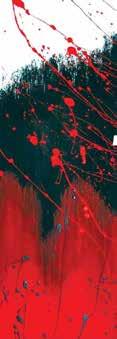
Canada 2022
Malaysia

174
2012
Singapore
2012 Philippines


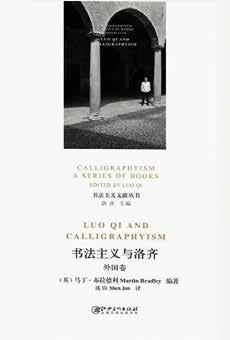

175
2013
Bangladesh 2019 China 2017 Philippines
Malaysia 2014




176 THE BLUE LOTUS
https://issuu.com/martinabradley/docs/on_the_island https://issuu.com/martinabradley/docs/being_here_now_ https://issuu.com/martinabradley/docs/malim_nawar_morning
https://issuu.com/martinabradley/docs/love_s_texture

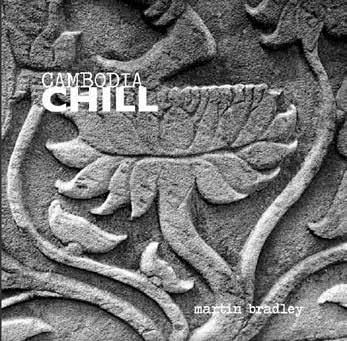


177
https://issuu.com/martinabradley/docs/on_the_island https://issuu.com/martinabradley/docs/lotus https://issuu.com/martinabradley/docs/cambodia_chill_re-issue https://issuu.com/martinabradley/docs/remembering_whiteness_booklet
LOTUS CHAP BOOKS
THE BLUE LOTUS













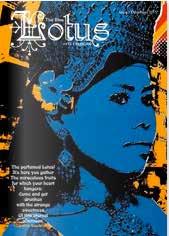


178
The Blue Lotus magazine is published by Martin A Bradley (The
LOTUS BACK ISSUES
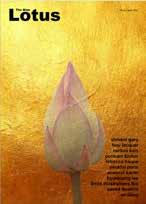

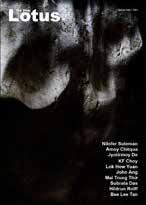

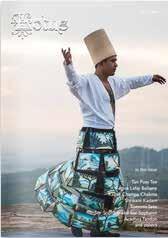


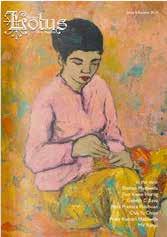

...a selection
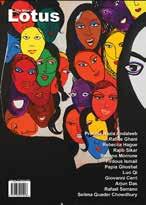


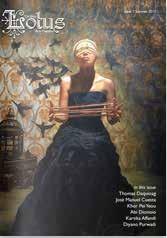

179
(The Blue Lotus Publishing), in Colchester, England, UK, 2023


180 ISSN 2754-9151 • NO. 59 • Autumn issue • 2023 • THE BLUE LOTUS is published quarterly by The Blue Lotus Publishing (M.A.Bradley), Colchester, Essex, England, UK. © 2023 M.A.Bradley. All rights reserved. issue no. 59 Autumn 2023






















 Māra Chin, Christian Develter
Māra Chin, Christian Develter







 Ed.
Ed.









































































 Young Woman Reading, Osman Hamdi Bey, 1880.
Young Woman Reading, Osman Hamdi Bey, 1880.





 Ushak Carpet, West Anatolia, late 16th C.
Ushak Carpet, West Anatolia, late 16th C.
 In the Mosque, Ludwig Deutsch, 1929
In the Mosque, Ludwig Deutsch, 1929


 Rider and his Steed in the Desert’ by Jean-Léon Gérôme, 1864.
Rider and his Steed in the Desert’ by Jean-Léon Gérôme, 1864.




















 Bono Stellar, (art installation)Theta
Bono Stellar, (art installation)Theta





 Victor Chin (Chin Choong Seng), 241 Beach Road, Singapore
Victor Chin (Chin Choong Seng), 241 Beach Road, Singapore










 Ed.
Ed.










































































